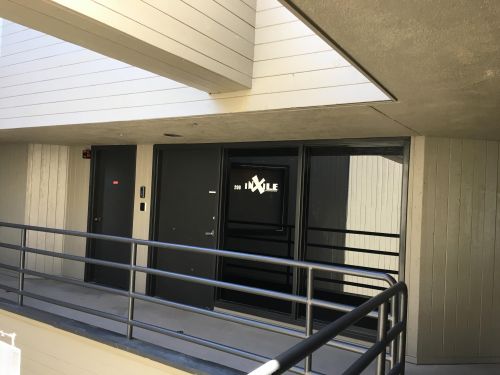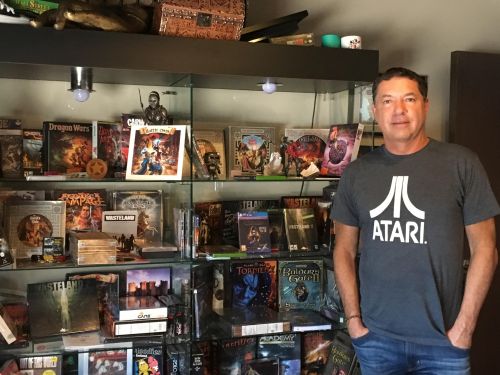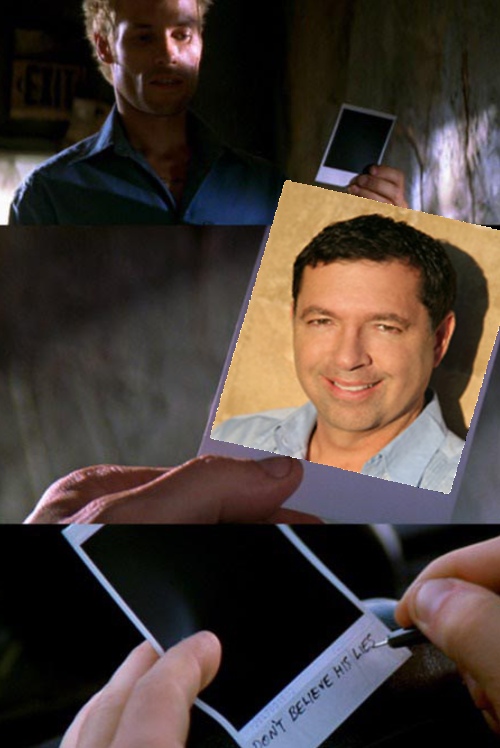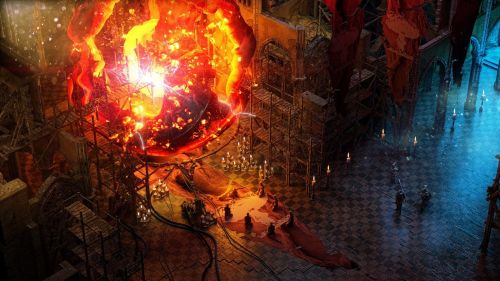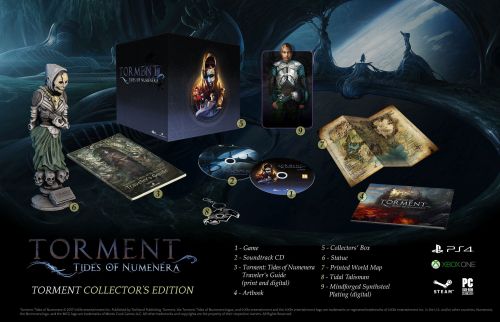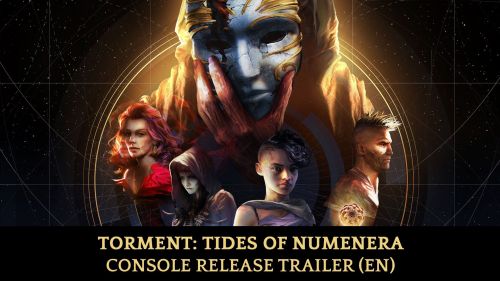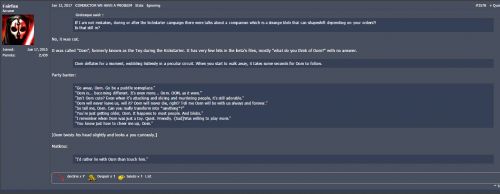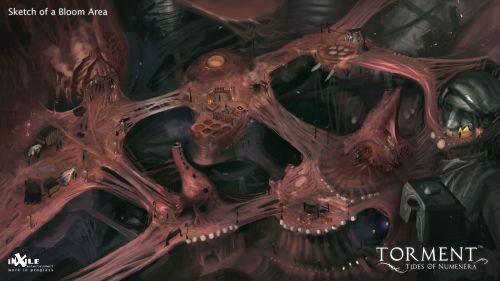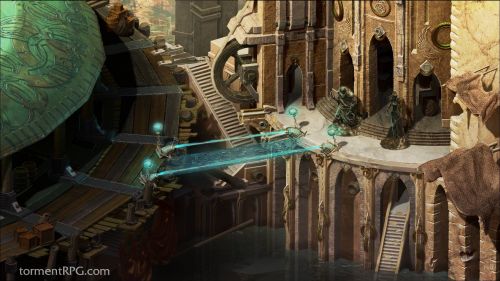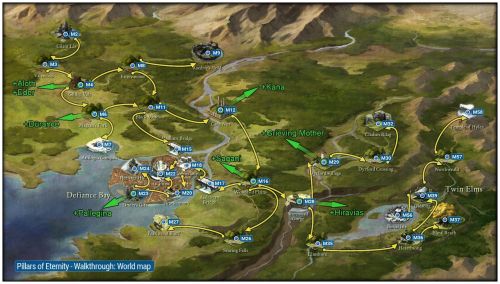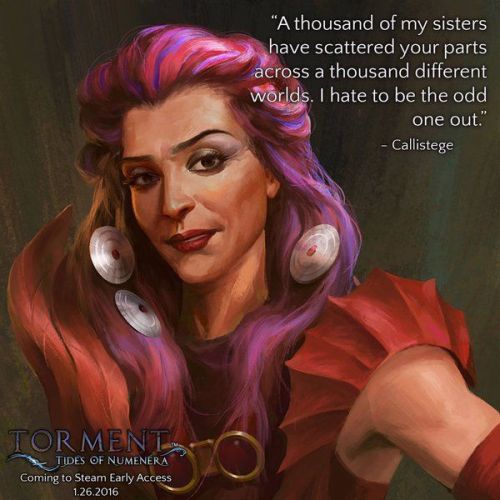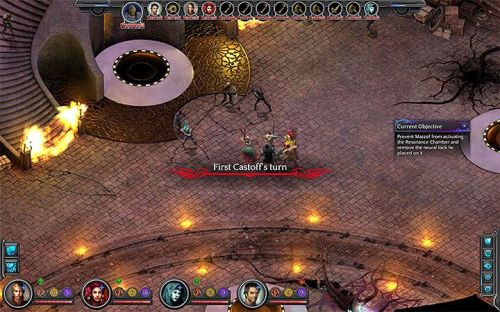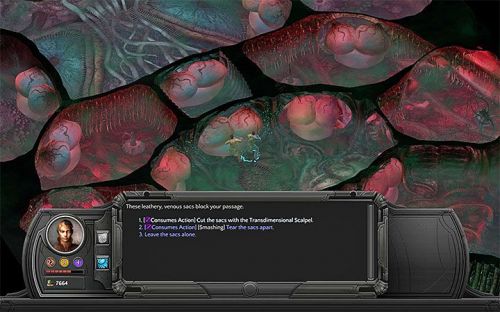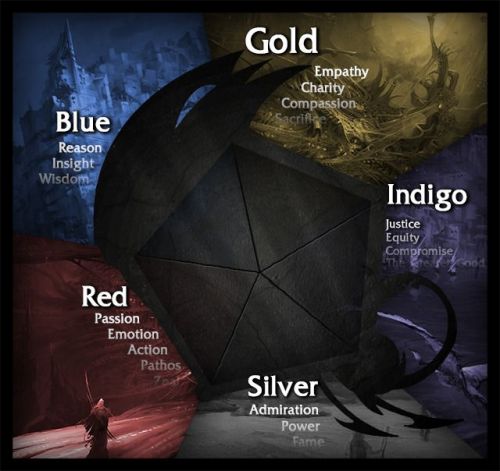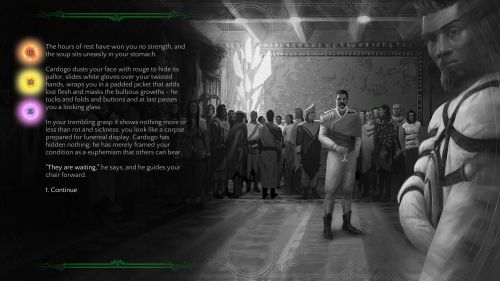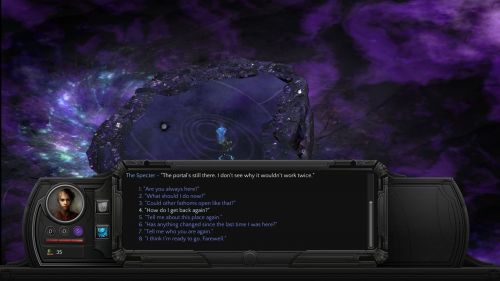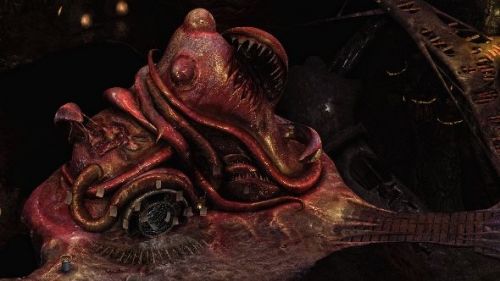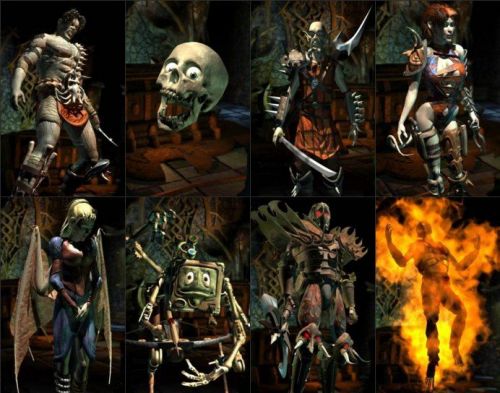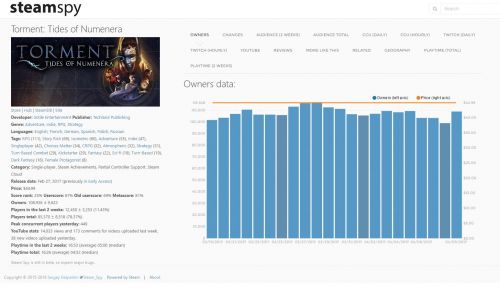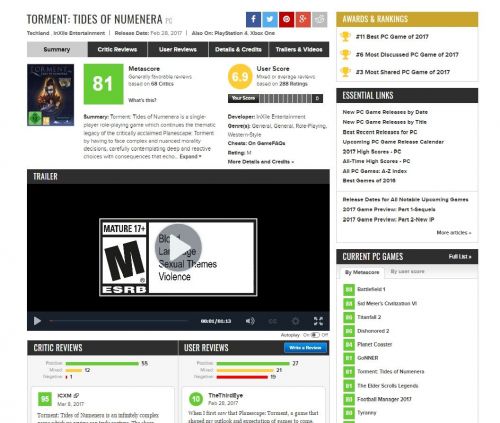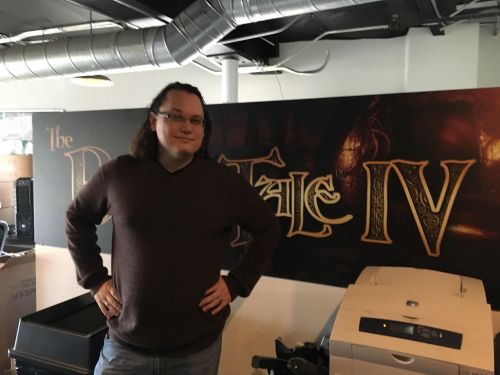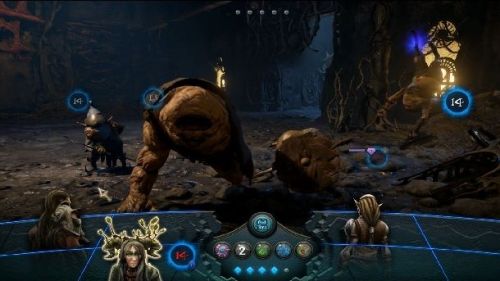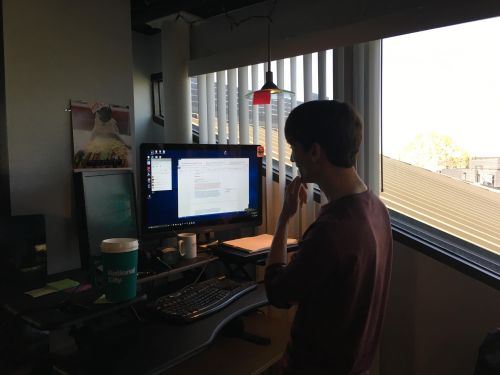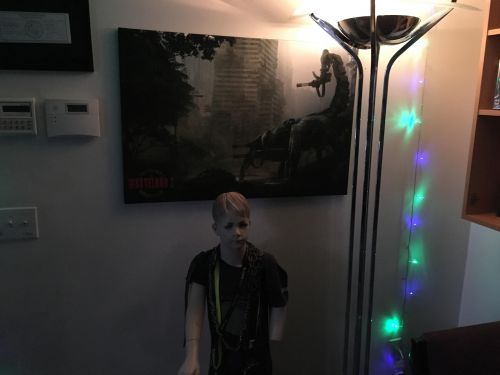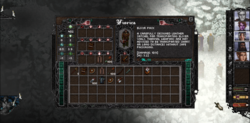RPG Codex Report: A Codexian Visit to inXile Entertainment
RPG Codex Report: A Codexian Visit to inXile Entertainment
Editorial - posted by Infinitron on Thu 13 April 2017, 00:18:30
Tags: Brian Fargo; Colin McComb; David Rogers; George Ziets; inXile Entertainment; The Bard's Tale IV: Barrows Deep; Torment: Tides of Numenera; Wasteland 3Ever since Techland canceled our interview with Brian Fargo last year, our relations with InXile have been strained, to say the least. And now that it has been a month and a half since the release of Torment: Tides of Numenera, it's quite clear that the game has not been a success. It may not be a coincidence that shortly after its release, we received an entreaty from inXile PR representative Jim Redner. Jim told us he was seeking to make peace with the Codex, and that he was willing to hear our demands. Our initial proposal was a humble one - a reveal-all AMA with George Ziets, probably the only person at inXile who still has our community's trust. To that Jim responded with a counter-proposal - an in-person visit to inXile, to be followed by an AMA with several of Torment's developers. That was an opportunity we couldn't pass up, and so a couple of weeks ago we dispatched our secret agent in Southern California to inXile's headquarters in Newport Beach. Today, we're happy to present the report of his visit to Brian Fargo's court.
When the DarkUnderlord first approached me to interview InXile, I came up with many excuses: I worked full time; I haven’t finished Torment: Tides of Numenera; I never interviewed developers before. I would soon learn, however, that the DarkUnderlord gets what he wants, and so on a sunny Wednesday morning, still groggy from binge finishing Torment the night before, I got in my car with a list of questions drawn from the Codex horde, and set a course for Newport Beach, California: home of InXile.
Having lived in southern California for most of my life, I’m used to the stereotypes: hippy liberal feminist environmentalist celebrity-worshipping surfers smoking pot at sun baked beaches getting stuck in traffic while attending gay pride rallies. But southern California is also home to two of the most grognard of grognard developers, at least in theory: Obsidian and InXile, the remaining offspring of Interplay. It would not be an exaggeration to state that they are, or are close to being, the most talked about companies within the Codex community, though whether that talk is positive is a different story.
It was with great expectations, therefore, that I crawled through the 10:00 am traffic into Newport Beach, searching for a company sign that I remembered from driving past InXile’s headquarters years before. The sign, however, was nowhere to be found, and I had to double back to the location Google said should be the address of InXile. There, I found Jack’s Surfboards, whose attendant smiled knowingly as I inquired about InXile, as he must have each of the hundreds of times the question was asked. “Up the stairs, outside,” he answered in a practiced voice. It was such a simple thing, not at all what I thought it would be.
While ascending the stairs towards InXile’s unassuming office, I was greeted by an equally unassuming man wearing a cap, who introduced himself as Jim Redner, public relations. I recognized him as the liaison who reached out to our nefarious DarkUnderlord, to whom I owed the pleasure and pain of my visit. Jim bade me follow, and soon I was leaving behind the bright, balmy streets of Newport, California, and stepping into the sunless depths of InXile’s development studio.
It was then I realized that, though it had the appearance of a basement, InXile’s headquarters was actually a temple, a shrine to the old gods who ruled while the industry was still young. Their worship thereafter diminished, but not entirely forgotten, they have retreated to the cloisters of faithful acolytes, who continue to attend, waiting, praying for a time when their gods shall be relevant again. Here, in a fortress funded by belief and regret, the remnants of Interplay’s glorious past gathered, hoping to raise a requiem to some of the greatest video games the world has ever known…
In the throes of a religious experience, I barely heard a small voice - or was it many voices, like a hive mind? - calling out to me. A tiny red man with pointed ears whispered to me of broken promises and tainted legacies, of mediocre products, canceled interviews, and false accusations. Suddenly, I remembered who I was and what I was there to do. I turned to Jim and said that, since I was already ten minutes late, we should do the interview at once. Jim complied and introduced me to a man I recognized as none other than Brian Fargo, the founder and CEO of Interplay… oh, and of InXile.
Brian welcomed me into his office - a quaint, smallish room, of which the most prominent decorations were a library of old games in their original packaging and a Wasteland 2 poster. I recognized many of the former, including Codex favorites Fallout, Planescape: Torment, and Baldur’s Gate. It had to be explained, however, that the latter was embedded, in fine print, with the names of all the backers of the Kickstarter campaign. I squinted to read them.
The office was a little small for conducting an interview with several people, so we soon moved to the conference room. While waiting for my Windows to update, we made small talk. Brian joked that he half-expected the Codex to stand him up, as poetic justice for InXile’s treatment of our community at Gamescom. I told him it would have been too obvious, but secretly cursed at a missed opportunity.
Soon after, I was greeted with a familiar chime, and with no further delays, the interview began.
First, I want you guys to introduce yourselves.
Brian: I’m Brian Fargo, CEO and leader of InXile.
Jim: I’m Jim Redner, I do PR for InXile, but you’re not going to have many questions for me. I’m just here.
Brian: Before we have a question, first, I want to apologize to you guys. I think Gamescom was terribly mismanaged, the entire process of it. It shouldn’t have been canceled. I think there was insult to injury in that it didn’t even appear you guys broke embargo. I think somebody said that you guys weren’t a first tier website. There was a lot of insulting stuff. I apologize for the whole thing and the way it went down.
I always used to talk with the Codex. The year before, they’d come out with all their difficult questions and we’d have fun with it, and it was okay and that was alright. It was never going to be we’re not going to talk to them again or any of these things I know have come up.
It was very unfortunate everything happened that way. There was a series of things that went on. Some of it was bad information, some of it was bad communication. You guys are owed an apology for that. I want to get that out of the way.
Thanks for the apology. Since we’re already talking about this topic, why was the Gamescom interview canceled? You guys said the publisher might have been the ones that made the call?
Brian: Well, I don’t want to point to specific people because that’s certainly not right for me to do. But in the beginning an embargo was supposedly broken and that made some people upset. Then we find out the embargo really wasn’t broken, but that information didn’t come out until later. But then the Codex reacted negatively and put some things up there, I don’t know what, and that made some people upset.
It was a bad comedy of errors that started out with bad information. There was a reaction from the Codex, I can understand why, which turned into another reaction, and then everybody was upset and said forget it.
I thought we were going to meet up until … We were going to do a demo, but then even that was canceled.
So you’re saying it’s all a misunderstanding based on an embargo the Codex didn’t actually break.
Brian: That’s right, it all started with bad and false information that you guys broke an embargo and then it just spun out. It was poorly handled and I apologize on behalf of everyone involved. My intention was always to meet with you guys, and unfortunately that’s when the relationship got poisoned, which was too bad. I was frustrated sitting there and even though I personally had nothing to do with it, I thought it would work itself through over time. But it hasn’t, so I would love to fix that.
I quite used to enjoy reading the Codex. I mean, it’s become more difficult over the past period of time because it kind of became caustic after that but it’d be nice for it to go back to normal because I learn a lot from reading. At the end of the day, we’re like on the same page here, because you guys like a particular type of roleplaying game and there’s not a lot of company like us that make them, and we should be able to get along better.
How does InXile see the Codex? You said you used to enjoy reading the Codex, but now it’s become caustic, etc. Can you explain this a bit more?
Brian: I used to joke that the Codex is the website that makes developers shiver. I used to have fun with it because they were always kind of tough and I could handle a certain amount of toughness. Recently - I kind of stopped looking at it - but I heard it was saying horrible things about our guy in Thailand who was running an orphanage, or that there was Nazi stuff. I was hearing about some really horrible things, and I didn’t want to engage with that kind of reading because it would just put me in a bad mood. So that’s the kind of stuff I would say I don’t like.
Okay, that’s fair. But the Codex is unfiltered, it’s free for all.
Brian: I get it. It’s the internet. I just think it took a bad turn after it. More so than it used to be, I guess is my point.
Jim: I think what Brian is saying is that the Codex got more negative after Gamescom.
Brian: And I would say, perhaps, always tough, okay, maybe not as objective as it used to be, before that. It seemed like it got less objective and it’s not as helpful if people are too upset because then it’s hard for me to glean interesting and useful information.
There are always people who are going to be edgy for the sake of being edgy. You can’t expect everyone to be objective on the internet.
Brian: Sure, and I think it’s more about the ratio or preponderance. The bottom line is that I’d love to get it back to the way it used to be if it’s possible.
By normal, do you mean developers would start posting again on the Codex, start reading again, etc.?
Brian: I think my guys still read it, and I think they still post on it sometimes. Sometimes they come back and they’re upset. Again, it’s an issue of the preponderance and ratio more than anything. We’re not going to tell people how to behave. I’m just trying to offer an olive branch here so that you guys at least understand that I’ll be honest about things we fucked up, and that was a mistake, and it was poorly handled.
Jim: I know that someone had mentioned that the Codex wasn’t top tier but for RPGs, I want to say, we view them as top tier. In the RPG community, top tier means different than it does in first person shooters. The Codex is top tier because they’re day one, they’re the people who push the games, these RPGs, in our community, and we’re looking forward to continue working together, to continue meeting up at E3 and PAX and so on.
At this time, a slim, youthful man with angular features and a perspicacious aura slipped into the room. I did not recognize him at first, but I knew who he was, as Brian had said earlier that George would be joining us for the interview, and there was only one George at InXile that he could have meant.
George Ziets: I am George Ziets, I am now lead designer on Wasteland 3. Nice to meet you.
What's InXile's future direction? Recent comments on Wasteland 3 suggest more focus on graphics, cinematic conversations, and streamlined mechanics. Your second studio is working on a VR title. Are these representative of the “games we would want to play ourselves?”
Brian: Well, specific to Wasteland 3, I think if you liked Wasteland 2, you’re going to love Wasteland 3. It’s just as deep, just as morally nuanced, combat system is the same, it’s party-based. The visual improvement – we know we always have to constantly improve visuals. One of the things we hear from RPG websites is that visuals don’t matter, but they really do at the end of the day. We have people complaining about the visuals in Torment, or in Wasteland 2, or in Pillars of Eternity. We always have to keep working on our visuals, but better graphics, hopefully mean better immersion. Wasteland 3 is just as deep as Wasteland 2, it’s not simplified.
George: We are not abandoning things like choices and consequences and the things we love to do. We are improving some things on the graphical side, we are talking about having the close up conversations for important NPCs, which is to give more character to the NPCs and make them a more impactful experience. But we are not giving up on interesting story - that was literally the first thing I did on Wasteland 3, which was to write the story for it. We are not giving up on choices and consequences. If anything, we’re trying to make those more impactful and less subtle.
Brian: One of the things we need to do a better job of is better selling our cause and effect mechanics. We tend to put it so deep and so nuanced that you’d need to play the game two or three times, or to be told about it, practically. We need to better telegraph it, that’s one of the things with Torment – it’s incredibly reactive, that’s why there’s so many words, but it’s really hard for you to understand unless you knew what was supposed to happen, and that’s what we need to improve on because I think we’re doing more depth than just about anybody but it’s not being recognized because we’re being too subtle about it.
In general, are you planning to continue making sequels and games in existing franchises, or are there plans to expand, develop new IPs, and so on?
Brian: We want to keep doing roleplaying games, that’s for sure, that’s our forte. Caveat: I’m not saying we’ll never do any little one-off in other genres, but roleplaying games are all we have in our plans. In terms of the future, I don’t want them all to be spiritual sequels or sequels. I like to do some original stuff also.
Are you guys going to continue using Kickstarter or Fig to secure funding? Was that a productive experience? Do you guys believe in it?
Brian: Well, starting with Kickstarter, we wouldn’t even be sitting here having this conversation if it weren’t for Kickstarter. We literally couldn’t get funding to make these kinds of games, period, so that was a great experience for us no matter what. I think the winds are shifting in terms of the ability to raise money via Kickstarter. Fig is very interesting in that if we turn around and make everybody a bunch of money, it’s probably going to be an easy conversation when we go back again and say, “hey everyone made X amount of profit, you guys want to be involved in this other project too?”
So, I would say “maybe.” Now, it all depends, it could be that one particular product breaks out and sells a million copies and we don’t want to do crowd funding. But I like crowd funding, I like the communication, I like the interaction, I like the audiences being super intertwined, in giving feedback during the process, which is very valuable to us, because I like to get the feedback during production rather than after the fact. When people are invested in it, they tend to have more energy to get involved.
Most of this interview will be about Torment, but I wanted to start at the beginning, with Planescape: Torment. Planescape: Torment was one of the most highly acclaimed CRPGs of all time. In 2014, it was voted the best CRPG of all time. This is one of the big topics for Codex fans and is one of the reasons the Codex community was so angry about Tides of Numenera. I’ll start with the most basic questions: how much did Planescape: Torment cost to make? How big was the team? How long was the production period?
Brian: I’m a little bit guessing, but would say between 3 to 4 million dollars. Keep in mind these were 1998 numbers, comparable to about 2 to 3 times that today.
Colin: The team was 35 to 40 people. That would include QA, not just the full-time team.
Brian: I’d be guessing 25 to 30 people. I don't count QA.
Colin: It started in 1996, because it was in pre-production when I first showed up out there in October 1996. I didn’t move onto the team until April 1997, and then we got side-tracked by Fallout 2. We shipped in December 1999 so it was at least 3 years.
How well did Planescape: Torment sell? The Codex believes it sold in the area of 400,000 copies.
Brian: 400,000 sounds about right. I remember Fallout 1 sold 600,000 units, and Planescape sold less than that. Baldur’s Gate 1 was our big seller. That was over a million copies. That was the big boy. Now I couldn’t tell you at what price those copies sold at, and I couldn’t tell you how many it’s sold since then.
George: What was the time frame of the 400,000? Over a couple of years?
Brian: It was over several years and probably included some sales. That’s one of the mistakes a lot of websites make, I don’t mean the Codex, they’ll sometimes run the numbers and they’ll assume full price, and go “gee look at all the money they made” but they don’t know that it could’ve been half of them were for $10.
Why did InXile decide to pursue a sequel to Planescape: Torment, which didn’t sell very well, without the Planescape setting, the Planescape: Torment license, or perhaps most importantly, Chris Avellone as lead designer?
Brian: We knew we wanted to kick off another project, so I thought there was this really unique moment in time during which Colin was available, Adam was available, Monte Cook had just done the Numenera setting – we couldn’t get the Planescape license, we tried, they said no – but the guy who helped invent Planescape had invented another world which we thought was kind of unique. We hoped we could get Chris Avellone involved, and we ended up doing so. I thought it was a one-time opportunity to give that creative team another shot at building a product which was similar – and by similar I mean a game that relied on reading and which was strange and otherworldly, and to give them an opportunity to create a game that was very different from your standard RPG experience.
Obtaining the Planescape license was impossible at the time?
Brian: Not possible. I tried.
Colin: I would also add that I tried as well. Back in February in 2012, Avellone, Dengler, and I had talked about trying to get the Planescape license and that didn’t go anywhere.
How much did Torment: Tides of Numenera cost to make? How big was the team? How long was the production period?
Brian: It depends on if you count pre-production as production. It really got into full production in late 2013. The crowd funding was finished around summer but there was a lot of writing and pre-production for 5 or 6 months. We didn’t really start rolling until the end of that year. So a little over three years.
Brian: The team size varied a lot.
George: In the early days it was quite small for quite a while.
Brian: When it was running at full capacity it was 30 or 35 people.
Can you give a bit more detail? How long was it quite small?
George: That’s a good question. I do know that pre-production it was quite small. When we entered production, it gradually ramped up.
Brian: A one person per month sort of thing.
Colin: In pre-prodution, it was really just narrative guys: Adam, Kevin, me, George, Steve Dobos, and I think Erin Myers.
George: I even came on pretty late for pre-production.
Can we get a percentage break down of the budget? In terms of programming, art, music, scripting, multi-platform support, etc.?
Brian: I don’t have that off the top of my head. But the budget was well in excessive of probably 8.5 million dollars. A lot of people assume that crowd funding money cover 100% production but that isn’t the case for us. We’re usually augmenting development with our own money and with outside funding from publishers and deals.
I think the Codex is especially interested in the amount of budget allocated to console support.
Brian: I know that is a hot topic because people feel the game suffered from console. In reality the inverse is true. The cost of doing the console conversion was relatively inexpensive. Of the money we got in from console, it only cost us 20% of it to put it on console. The other 75% all went in to making this game better.
The design was already done. We knew the product. We weren’t cutting or changing for console. The game was not ready to ship a year ago. No way. That console deal bought these guys more time to make it better. We already had the code from Wasteland 2, so it just bought us more time. Almost 75% of the console money went into buying more time.
It’s my job to give them more time. Step back for a bit - who makes the best products in the business? Whether it’s Blizzard, or Valve, they have the luxury of time. That’s the most important thing, so I try to give these guys the most time I can, and I got to be clever about it, whether it’s doing a crowd funding campaign or a console deal, I try to give them the most time possible to make the most polished product I can.
Kevin Saunders left before the end of production. Can you talk about why he left and how his departure affected production?
Brian: I can’t talk about an employee’s specific performance, but what I can do is to provide you with a factual history of things. Kevin left the project in late 2015, right? At that point, we were roughly two years into production. At that point, we’ve gotten the first pass of combat. The story was not yet at first pass. No abilities or weapons were in outside of the alpha systems. And so, at that time, if we had gone along that route, the game would not be done until the year 2018. I could not afford to stay on that path. I had to change what we were doing.
And, to talk about scope, the product was wildly over scoped. Even today, after we made the “cuts,” the original specification for the game was 600,000 words. You know how many we are at now? It’s 1.6 million words, probably a world record for a single player game. I think the only games that have more word count is MMOs done over a long period of time.
George: When recording, the guys who were doing the recording were saying, this is like one of those big MMOs, and they were shocked that it was a single player game.
Brian: After cuts, it ends up being several times what we wanted it to be. Planescape: Torment, the number that was thrown around a lot was 750,000 words. But when you talk to Avellone, he would say we actually double counted some sentences, so it might not even be that high. I think the Bible is like 700,000 words so that seems plenty of words to do a narrative piece, something that is as big as the Bible.
So basically, after two years in, I had to change plans. So those are the facts. I’m not trying to disparage Kevin, I don’t want to talk negatively about him in any way, but I can at least speak to the facts behind what was going on at that point.
More than a dozen promised stretch goal features were cut from the final game. You’ve already provided the reasons for many of these cuts on the Eurogamer interview, but most of the Codex disagree with the idea that the cuts made the game better, since it felt like a betrayal of donors’ trust. Why didn’t you start with a more reasonable feature list? What does one unfulfilled Kickstarter promise matter?
Brian: Well, you’re right, but let me answer that broadly and specifically. One of the things about crowd funding is that the crowd becomes our publisher, ultimately. Now, one of the things we like about industry publishers, at least the ones we work the best with, is that they are agile, that they don’t hold us to the specifics of the contract, that they kind of trust our judgment to do the right things in order to get the product complete and to hit the main beats we want to hit.
Now, we did do those things and I’m still very proud of the product, but with crowd funding, it’s different, because they get to say that we promised those things. Now, in a normal publisher relationship I bet they’d say those were the right calls to make based on all the things I’m describing to you. But again, we’ll fall on our sword for this, we have to be very careful about what we promise if we’re dealing with a crowd funding atmosphere.
We underestimated the latitude we’d be given in order to make these changes that we thought would be better or in some cases we couldn’t get into the product until the year 2018. So, in some ways, like word count, the product was much grander than we ever dreamed of or planned for. I think that goes in the plus column. But okay, we’re missing some companions, though we’re bringing out updates to put them back in.
I’d still say – but don’t get me wrong, I’m not saying that we should have promised what we didn’t put in – that even if we had two or three more companions, the totality of the experience wouldn’t have changed that much. You played the product, right? There’s not much combat in the game, and the few that you have, you can skip them. Does a crafting system really make sense in a game that has less than twenty combat experiences?
In the future, we will be much more careful about detailing the specifics. With Bard Tale IV, with Wasteland 3, there’s nothing in those lists that we’re not going to not do.
Jim: Actually, to add to this question, we might want to speak about communication as well.
Brian: Right, the other big mistake we made, was that we communicated poorly. If we had done a better job this would’ve been less of an issue. We were coming out of the last year, we weren’t quite sure of all that was or wasn’t going to be in. We knew about the NPCs, but we weren’t sure about the Voluminous Codex, there were some discussion points on things. We got busy with the holidays and underestimated how much we could do. I know it looked like we were hiding it, but we weren’t.
I think the reason is that people on the forums found out first, before your announcement.
Brian: I know, but we didn’t want to give partial news, we wanted to come out with one announcement, but we kind of underestimated and it fell off our radar. That was a major screw up and the biggest problem. I think, had we in the beginning done a better job at communication it probably wouldn’t be as big of a deal as it is today. Lesson learned.
Around what time did it became obvious that cuts had to be made? You guys talked about making an announcement; around what time did you decide this?
Brian: Late last year I think.
George: Some were even more recent than that. There were some we were holding out hope that we would be able to finish, like the Voluminous Codex.
Brian: The project was over-scoped from the very beginning.
During the Kickstarter campaign for Torment, you guys had plans for an extended preproduction. In retrospect, many large changes were made to the game over the course of its development. In retrospect, did the game's development reveal the limits as to what can be achieved in preproduction, or would you stick to the same process for similar games in the future?
Brian: In this particular case, I would say no. That doesn’t mean you shouldn’t do pre-production. But in this case, I don’t think we got as much benefit as we should have seen.
How would you fix this process?
Brian: I’m a big believer in iteration. I like to use iteration as quickly as possible. I even place more importance on it than preproduction, if I had to choose between the two. I think I have a more like-minded person on the project now than perhaps I’ve had in the past.
This is a criticism the Codex brought up during our analysis thread. Your lead designer lives in Thailand, while your lead writer lives in Michigan. Did this present a logistic problem for development? How did your team communicate?
George: A lot of instant messaging. A lot of calls when we needed it. A lot of meetings in this very room where we’d put Adam and Colin up on the screen and talk about stuff. We had to put a lot more focus on making sure we were communicating because we couldn’t just walk over to each other’s desk. In general, it pretty much worked. I’d talk to Colin on IM at least once a day. Some of the guys, like the writers, were on IM almost all day.
Colin: Yeah, we got piles and piles of IM.
George: We substituted electronic communication for walking over to each other’s desk. In some ways I’d even say we communicated more than had we been in the same office.
So you don’t think this was to blame for any difficulties during development?
George: I think the only place where it hurt us a little bit was Adam being in a different time zone. I think that was difficult. The electronics communication was not necessarily a bad thing at all. I keep saying we should go to the VR office and live wherever we want. The time zone thing was occasionally an issue, but Adam was very good at being responsive. He would get up at ungodly hours in the morning to answer emails and to talk on IM when we were both on at the same time. There was inconvenience there but I would not say that was a major source of problems.
How would you describe your critical process? How does a piece of text, art, map, etc. make it into the game?
George: There was a lot of review. Let’s just talk about the area design process. I think I’ve talked about it in the past but I’ll go over it again anyway.
Zone design constraints were the first things we did for a zone. It was basically Colin saying these are the things that need to happen here for the story, and here is my idea for the overall – “Sagus Cliffs is a city with blah blah blah.” This gets passed to a designer, usually me or Adam, because we were the people with the most area design experience. We would write the zone brief: here are the quests that would be in this zone, here’s the path through the zone, here’s some of the main characters. Then everyone would review that, there would be comments, we would all sort of talk about how to improve it, and then the next phrase would be a zone design document.
The document had level lay outs, detailed question descriptions, and so on. At each of these points, I and other people would be reviewing them. Our design documents were massive documents with tons of comments throughout them, with everyone collaborating and making sure they were okay with it. Then it would get passed to the writers who would implement it, and then we have more people reviewing the dialogue, including me. There were a lot of reviews.
It was the same with the art. The zone design documents would be used to create level layouts, D&D style on paper. That would be given to the designers who would do a block out. Then the block out would be given to the artists, and at every point the major stakeholders would be reviewing them.
Did the fact that InXile was taking on several different projects – Wasteland 2, Director’s Cut, Wasteland 3, Bard’s Tale 4 - at the same time affect Numenera's production? Why did you decide to take on so many projects at the same time, given this risk?
Brian: The majority of the entire company was on Torment, that was very much the case. Maybe we could’ve moved the start time up a couple of months while we were doing Director’s Cut things. Maybe. But overall, they had the lion’s share of the resources of this company.
I’ve been involved in a lot of products before as you know, and whenever we’re doing something different or innovative, they’re messy behind the scenes. Fallout 2, behind the scenes, was a mess. Planescape: Torment was a mess. The original producer for that project was replaced. So this drama is part and parcel of development. I’ve been involved in very few products in which it was straight forward. The only times it was straight forward was, for example, Icewind Dale, where all the systems were in place, we knew what it was, it wasn’t that deep as a product – and by the way, it was one of my favorite games – but it was very straight forward, you knew exactly what you were doing, all the systems were in place.
When everything’s place, it can become more like that, but whenever you’re trying to innovate in any way, it’s always very messy. I’ve never been on a product where it was run perfectly and you know everything. There’s a great book called Creative Inc. by the founders of Pixar, in which they talk about how every Pixar movie starts off as a piece of shit. Those were his words. It’s basically a mess and it’s a false goal to try and make production perfect, because when you do that, production will not be perfect and you’ll have a dry product. So I think there is messiness that comes with the territory.
They’re messy. We could go back thirty years to talk about how all the different products were messy. From Stone Keep to Battle Chess to Descent, they all had some drama behind the scenes. You know, in production you could have a lead programmer quit in the middle, and you could lose two months because you have to train a new person to take over their code. Think about the cost of losing two months and what that would do. That didn’t happen in this particular case but I’ve had it happen before. You can’t just swap people out easily.
Speaking of people, what did Brian Mitsoda actually contribute to the game?
George: He wrote Oom, or rather he wrote the initial drafts of Oom. Now Gavin is doing additional work on Oom. But because Oom was ultimately cut, his work was not in the version of the game that was shipped, it’s going to be in the update.
Brian, you said it was messy, but why were there so few areas in the game? Defiance Bay alone in Pillars of Eternity has over thirty interior maps. Sagus Cliffs in T:ToN has two. How do you explain the difference?
Brian: One of the complaints about the game is that you could get through it in 30 or 40 hours, right? Now, think about a normal roleplaying game and how much percentage of your time is spent in combat. Whether it’s fodder or trash mobs or bosses, it’s usually over half the game. In Torment, it’s negligible. So we have a game that is actually larger than most but in which you can get through it quickly because we don’t force you to fight all the time.
George: We have the dialogue load of an 80 hours game. If we had the amount of combat in typical games, it’d be an 80 hours game.
Brian: I’d say it’d be longer. Wasteland 2 only had 500,000 words and it was an 80 to 100 hours game.
It’s fair to say you’re writing focused, but aren’t areas an art asset?
George: There’s truth to that, but since we had very little ‘you’re going to go this area and you’re going to fight a bunch of guys,’ it was basically just NPCs at various places in which you’re walking around and talking to and interacting with things. So we didn’t even end up needing all those different interiors and spaces.
Because there weren’t enough combat encounters?
George: Right.
Why were the old portraits revealed during the Kickstarter campaign and Beta dropped?
George: You’re talking about the original Kickstarter campaign? I think there was a female Last Castoff.
There were also some companion portraits from what I remember. Matkina, Callistege, Tybir, etc.
Comment: I was wrong here because it’s the Beta portraits that I was thinking about.
George: Tybir wouldn’t have been in the original Kickstarter campaign.
Colin: I think it was only Matkina that we had during the Kickstarter campaign.
George: There were various iterations on the companions. Colin, you might know this: who did the initial portraits? I know it wasn’t the person who did the final version.
Brian: I think it was Nils.
Colin: It was Nils.
George: There was a round of portraits that were done which you would’ve seen if you played the beta. For those, it was a quality issue. It was a decision at the art director level, who decided they weren’t of the quality we wanted them to be, and we decided to go with someone else who could generate portraits at the level we wanted them to be.
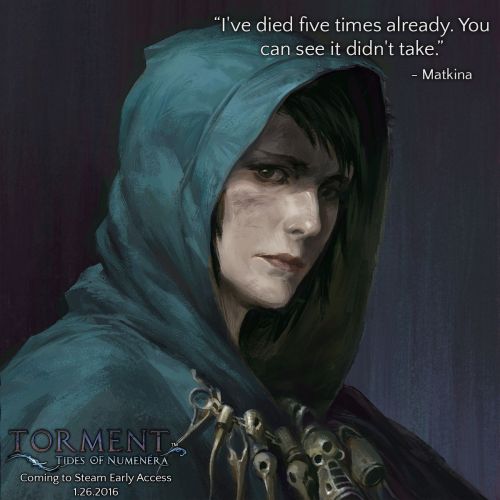
An early portrait of Matkina, who also has another, even earlier portrait that makes her look more alien.
Brian: But I don’t remember there being a complaint about the quality going down from the Beta.

The in-game portraits for Torment's companions.
Why weren’t there portraits for NPCs outside of your companions? The game has a lot of text. A few dozen portraits would’ve added a lot to the game.
George: Creating unique portraits for every character in the game, given the amount of NPCs we had, was beyond scope. It would’ve been a huge number of portraits, if you looked at all the NPCs we had in the game, it would’ve been a massive number of portraits to generate. What we didn’t want to do - and I can take the responsibility for that – was a case where there were like twelve portraits and every NPC in the game had to use one of those same twelve portraits.
What about the major characters, like the First Castoff?
George: She does have a portrait. What we tried to do was to make sure the critical story characters did have portraits. As far as I know, they do. Colin, does that sound right to you?
Colin: Originally, yeah. I don’t know that they made it into the game though.
Jim later checked for me and the major NPC portraits that made it into the combat are those that you see during Crises. There were none during dialogue.
The same question, but for voice acting - it would’ve been nice to have the first lines of NPCs or major NPCs voiced.
George: To be honest, this is another case of scope. Getting voice overs, especially for all the languages we were going to translate to, would’ve been a lot of resources. We just decided against it.
Brian: One thing to keep in mind is that the large word count kills you over and over again. Not only did we end up with 1.6 million words, but you had to put them into German, Russian, Polish, Spanish. It ends up being 5 to 6 times the original budget of what we wanted. It more than doubles but goes up exponentially.
George: We had a lot of European fans, people who pledged from Europe, and had we just done an English voice over and told our European fans, “well, sorry guys, but you don’t get the voice overs” that would’ve been crappy.
Who designed the Crises system?
George: Kevin and Adam did the initial work on it. There was iteration done by our Crises team.
You guys said the game doesn’t have a focus on combat. But there were at least six or seven Crises that were not avoidable. One of them happens about five to six hours into Sagus Cliffs, before which the player could resolve every situation without fighting. Doesn’t this create an awkward experience for the player, who go from nearly no combat experience to having to learn it the hard way?
George: Technically, what we promised was no combat – no fighting - and there are ways to get through them without fighting, without killing anything. You could stealth, which is the obvious one. Another example is the Stichus fight in Sagus Cliffs, in which the designers included those weird statues, which you could use to attract the enemies away and move through with a character not built for combat. We did make sure, that for most of the Crises that you were forced to go through, you do not have to fight.
Even in the Bloom at the end, if you were not an enemy of the Bloom, if you had not pissed off the Bloom, that one you could get through without fighting as well.
You mean the fight with the First Castoff?
George: No, I’m talking about the Bloom parts Crises.
Oh, the one with the doors. I didn’t find that one very difficult personally.
George: You must have not pissed off the Bloom. Because a lot of people are talking about, “I pissed off the Bloom” and I tell them “shouldn’t have pissed off the Bloom!”
So you guys are saying most of the Crises have solutions that aren’t violent.
Brian: All the mandatory ones.
George: All the mandatory ones.
What happened to the Tides in the name of the game? The player barely uses them and the quest to obtain access seemed like an afterthought. You said they were supposed to be central to the game & were supposed to hurt your companions while helping you. How come these mechanics didn't make it into the game?
George: There’s a few things going on there. One of them is what Brian said earlier about subtlety. There’s a lot of cases where the Tides actually do affect a lot of things. Just to confirm: we did a search through the game on the other day and found tons of cases in which your Tides were being checked. The problem is we’re not very good at telegraphing that to the player. There will be a lot of cases in which a character is reacting to you differently and you wouldn’t even know it was because of your Tides.
An example of this is in the Wayward Son quest, if you were Silver tide dominant, you could tell Piquo “you shouldn’t go off and get yourself fixed up; what you should do instead is join my cult and give me all your money; and he’d actually join your cult.”
You’re right about the telegraphing. There’s no simple indication or way to check how people view you in the game based on your Tides.
George: Yep. Also, Tidal surges do at times unlock alternate solutions to quests. But again, all of this stuff, had you not gone to Tol Maguur and unlocked your Tidal surges, you’d have no idea there are places in Sagus Cliffs where Tidal Surges could be used.
I have seen the Tidal Surge options, but to press it a bit further, the Codex is more curious about the promised mechanics, about Tides hurting your companions, for example, as opposed to just being a measure of personality.
George: So the promise early on was about Pain Casting, which evolved into Tidal Surges. There were a lot of things early on in the Kickstarter campaign which we evolved and iterated on a lot, and which we didn’t feel ultimately worked well in the game. There were quite a lot of things, like Pain Casting affecting your companions, which we didn’t feel it contributed to the overall experience. In some of those cases we feel it hurt the experience. We erred on the side of making the game feel more unified and better as an overall experience, as opposed to trying to be true to every one of those initial plans.
We should talk about the writing, since this is a big focus for the game. Why was the game so wordy to begin with? This seems to have become a trend with Kickstarter CRPGs. Is it really necessary to force the player to read a novel? For example, why were the Meres designed as choose your own adventure stories, as opposed to isometric scenarios?
Colin: As I recall, I was sitting in a meeting with Adam and a couple of other people, and we thought, wouldn't it be cool to quickly throw out a choose your own adventure story as one particular Mere? I mentioned that to Kevin, and Kevin said "what if we did that for all of them?" That would free up our artists for other stuff as well, so we thought it was a cool idea.
Brian: I wouldn't say we decided to be so wordy but that it became so wordy because they were trying to express all the subtlety and so on.
George: Part of it was due to the excitement of reproducing the Planescape: Torment experience, where there is a lot of wordiness. I remember early on, even on the Codex, I remember there being a lot of excitement: "walls of text! walls of text! we want walls of text!"
Turns out the Codex didn't want walls of text.
Brian: There appears to be a lesson here.
George: We felt there was excitement about that, and we did want to pay off on a strong, dialogue writing and text based experience, and making really imaginative characters, and having characters with a lot of different things to say that you could explore. But also making sure that all this was optional, and for the most part it is.
I think I should be a bit more specific. In Pillars of Eternity, Tyranny, and of course, Torment, the dialogue between the player and NPCs mostly takes on an inquisitive tone, in which you have all these questions you can ask about the NPCs, their background, their culture, and so on. In response, they effectively dump lore at you, and you feel obligated to go through these interactions, because it comprises the bulk of the content. This often feels like a chore, because the information is frequently irrelevant. Do you guys think there is a major market for this kind of reading?
George: We don't necessarily think that is a bad thing to have - the option to ask characters about these things. We try to make it as interesting as we can. Some of these explorations may not be related to the player or the main quest, but we intended them to be fun and interesting for the player to read. There was a lot of this in Planescape: Torment as well, and they even make fun of it in the game, where characters would say "you sure ask a lot of questions" to the player. There were a lot of NPCs in that game who you could ask questions about, but who weren't related to the main character or his quest, and who had fun and interesting things to say. We tried to reproduce that experience to the best extent we could.
Colin: Also, every NPC in the game does actually have a thematic reflection in the game. We made sure that everybody there was interesting and answered a primary thematic question in one way or another. The player is certainly not obligated to click through all of these questions. It's all a player choice, and we just wanted to honor what the player's choices were.
So from the sounds of it, you believe the wordiness was justified.
Brian: I think that was the experience we were trying to create. When you think about Wasteland 3, it's very different. I use the word 'banter' a lot. My favorite movies in the last couple of years have been Sicario and Hell and Highwater. They're more about banter and interpersonal relationships. That's a different type of writing and style and I really like that. But for this particular product we wanted to be more like Planescape: Torment.
Did you get any feedback during Beta or from QA testers about the game being too wordy?
George: No, not that I recall. We actually had people saying they liked it.
Brian: That was the surprising thing to me because remember we had it in early access and the response was overwhelmingly positive: "just give us more!" If we had more negative feedback it might have given us pause but we didn't.
George: I'll also say that since the game came out, there are a lot of people who came to me and who wrote about it online saying they liked it.
Brian: And in defense of the game, there's more people who had positive impressions of the game than negative.
According to Codex sources, there was feedback during Beta about the game being too wordy, and supposedly this was taken out in response but then added back later in the final Beta version of the game. Did this happen?
George: That was the introduction, I believe. There used to be a scene that was part of the introduction sequence, in which players operated with the tanks, and there were lore dumps about the Tides specifically, which we ultimately felt was not the best way to teach the player about the Tides, and we ended up getting rid of that whole scene because there was a lot of excessive information there.
So it was only this introduction scene?
George: Well, we did go through and remove a lot - some - of the lore dump that writers felt were not necessary to communicate or got the player off on the main story. So we did try to address that feedback.
Brian mentioned player impressions. It did indeed seem, during early access, that the feedback was overwhelmingly positive, even on the Codex. But currently, Torment holds a 70% Metacritic user review and a "mixed" review on Steam, with the entire first page of the Store page filled with negative reviews. How do you react to that? Do you think this was a consequence of your design decisions?
Brian: Well, I think there was a lot of factors there. The cut content, I think, had a large impact on why people are up voting the negative reviews. We have people who are upset that Techland gave statues away in their Collector's Edition and down voted us because of it, and I have zero control over that. I think it wouldn't be where it's at without some of that. But there's legitimate criticism, too, don't get me wrong. The game is not perfect, but I think the totality of the experience is very positive and that people who didn't know the game's history might be playing the game through a different lens than people who knew about the missing companions and cut content, and I think that is dragging it down to some degree.
But it is sort of surprising because in the beginning it was very positive and the early access was indicative of what the final product was going to be. It didn't suddenly become something else. We just gave more of *that*. I think there are other factors at work.
One of the main criticisms of the game's story is that it's too similar, almost like a repeat, of the original Planescape: Torment. Indeed, Planescape: Torment was considered brilliant because it subverted the popular CRPG tropes at the time, while Torment seems to go along with them. How do you respond to these criticisms?
Colin: In the time between Planescape: Torment and now, a lot of people decided to overturn all the tropes, and if you go on sites like TV Tropes, you'll see that everything you can possibly do in a game is a trope. So we just said, screw it, let's just tell the best story we can.
George: Another thing that I tried to do, and which comes out especially in the Bloom and the stuff I designed, is to evoke the tone and vibe of Planescape: Torment as best I can. Because I know that I, as a backer of a game like this, would've wanted to feel those kinds of things that I felt when I played through Planescape: Torment.
The Bloom was terrific, a lot of people on the Codex liked it. But characters and concepts like the Last Castoff, the Changing God, immortality, and so on, are very similar to those we've already seen in Planescape: Torment.
Colin: Some people are yelling at us because we are too close to Planescape: Torment, and some other people are shouting at us for not being close enough. I'm not sure what the middle ground is here.
I think the criticism is that Planescape: Torment story was very original at the time, but that when its story is repeated, it is no longer original, and people notice. With respect to it being too different, I think that's more about the game being insufficiently subversive. I guess this is a matter of opinion, but consider the companions. In Torment, your companions consist of a cunning and manipulative wizard, a greedy rogue who's out for himself, a cold, cynical assassin... These are tropes that are well-worn within the CRPG genre.
Colin: We decided, early on, that the world of Numenera was weird enough, and so we wanted to focus on telling weird stories, rather than having weird looking companions. We could've easily turned Aligern into a sysygy ghoul, or made Matkina a silver orphan. But that's all just surface stuff. Where I think we have done things very differently is that we gave them interesting back stories. I mean, if a woman who has fractured herself across different dimensions is ordinary, then I guess I'm pretty out of touch.
Brian: I want to add to this in that I think we should at least agree that there is a subjective nature to this. Because we do have people who have genuinely said that this is the best game they've played in a decade, and I do find that when people are mad they tend to have more energy than those who are happy and so that could reflect the feedback. We don't mind answering but I do think some of this is subjective and not everyone would agree.
Bringing it back a little, what would you say are the main influences on Torment, outside of Planescape: Torment?
Colin: Gene Wolfe, Jack Vance, Michael Moorcock, M. John Harrison, Moebius, oh and obviously Roger Zelazny.
George: Gene Wolfe is the biggest for me outside of Planescape: Torment. It's what I was strewing in when I was doing my design.
These are all authors? Any video game influences?
George: Not as much, we are a writing focused game and I think we got a lot of our ideas and concepts from fiction. Though I think Moebius is more visual.
Coin: Artistically speaking, we were influenced by a few movies as well. I'd have to look them up though.
We should talk about sales. Everyone can look them up for Steam. It's currently sitting around 120,000. Can you tell us how many copies were sold from other distribution sources?
Brian: Negligible.
Were these sales expected?
Brian: No, I'm disappointed.
What would you say are the main reasons for disappointing sales? You've already mentioned that the history of the game's development might have played a large role.
Brian: It's a lot of things. It didn't help that Zero Dawn, one of Sony's most original franchise, came out around the same time. The Nintendo Switch came out. The reviewers liked the product, I've seen people say that the reviewers are shills, paid off, but they're the toughest ones generally and really brutal and they'll find one little thing and blow the whole review apart, because of a single frame rate issue, they tend to be very difficult so, their responses have been - we've had some perfect 10 scores, so I can't help but feel that some of the reviews on Steam are colored by the production issues behind the scenes.
But it's no one thing. I do think over time, it'll find its audience. We have a huge wish list from people on Steam, so guess what, they're waiting for a sale. I think as more people come in who know less of the history, I think the rating will go up.
Oh, and it's worth noting that our Kickstarter backers, or anybody who buys it retail, cannot rate the product on Steam. It has no impact. So we have these other 60,000 people who are happy and their ratings mean nothing, because it was "free" and "free" codes don't get ratings on Steam. This includes retail sales! So when you buy a game from retail and then you go on Steam and put in your code, it doesn't count. It's sort of a funny system.
Any numbers for console sales?
Brian: I don't even know what they are yet. But given that they went out on the same way as Zero Dawn, I can't imagine them doing very well.
George, Colin, any comments about why the game might have done poorly with sales?
George: I think it's a niche game to begin with. We knew that going into it. There's an audience that loves a lot of reading and a lot of character development and you're not going to get the Halo guys playing something like Planescape: Torment. I do agree with Brian in that I think it is going to find its audience, much like Planescape: Torment gathered steam over time, I think we're going to do the same thing.
Brian: I think the reading is definitely... We live in a world now in which watching other people play video games, whether via Twitch or video streaming, is now key. Watching people read - I can't think of anything more boring than that. I was watching Patrick Rothfuss stream it and, he's having a great time, maybe he's biased, but you're just watching him read.
Colin: The people who are open to enjoying this game are enjoying the hell out of it. There's a reason the professional reviews are just ecstatic. I saw some guy claiming today: I started playing Planescape: Torment again and I have to admit I'd rather be playing Torment: Tides of Numenera right now. This is a subjective thing, people enjoy the things they like and there's no accounting for taste.
What lessons have you learned from Torment and its reception?
Brian: First, we have to be very careful about what we promise during a crowd funding campaign. We're used to having agile latitude behind the scenes and we just can't have that with crowd funding. That was a huge lesson, but I think we've already self-corrected on it. That's a huge, HUGE one here.
The second is just to get into production faster, get out of preproduction and into a period in which we can get a feel of the game and iterating on it. That is the absolute single most important thing, and that's how we're doing Mage's Tale, Bard's Tale IV, and Wasteland 3. They're all being done that way.
Colin: It's important to have regular communication with people, and to tell them about why something is happening with the product and the decisions we're making, what it is we're doing and where we're going.
Brian: Right, improve our communications, and I said that while it shouldn't happen in the future, we need to get any bad news out faster so it doesn't appear as though we're trying to hold it back. That was a big mistake and we got to improve our communications. We're actually bringing on a full time person to handle social media. That's not an excuse, but it's going to help. We need someone to go on the forums. Right now no one owns that job and it's part time for everybody and that doesn't help.
Colin, is it fair to say that in terms of the story and the writing, you think the game is going to find its audience, and that there's not a lot to take away from its reception?
Colin: There's always ways to improve your craft, to improve your writing. At the same time, there are a lot of people who are extraordinarily happy with this game, and I don't think necessarily that some of these reviews on the Codex have been particularly fair, for instance. I'm not going to complain, because obviously you guys like what you like, but I'm always looking for ways to improve and continue doing it.
George: I think companies in general are getting smarter about using crowd funding. In the heydays of 2012 when we were all like "go! crowd funding!" we were throwing out lots of ideas, and it's kind of interesting when you're looking back at it from a fan perspective. You're getting an insight into the way development often works. When you saw many of the things we talked about in the Torment campaign and also in Pillars of Eternity, not all of them came out as well as they would've hoped in the final product. It's very common in the early days of a project to have a lot of ideas like Pain Casting. But many never make it to the end. They just don't work well together or they're not servicing a cohesive game. What you saw in the crowd funding campaign was that early phase, and unfortunately people who aren't familiar with the industry think "oh, that's all going to make it into the game" but that's not always how it turns out.
So giving a more realistic view point of what the game could be, not necessarily making a promise out of all of our crazy ideas in the beginning, that's definitely something we learned. In Wasteland 3, I read some people online saying "ah I wish there were more specifics!" The reason we didn't do quite as much of that stuff was because we learned from Torment those lessons, and we want to tell you the stuff we can guarantee we'll deliver to you, and maybe surprise you with more.
Brian: We have a board in the other room with Wasteland 3 ideas. It was just full of them. The team earnestly wants them all in. But I'm telling you they're not all going to make it in. But they earnestly do, and want to get in as many of them as they can.
The Torment interview was at an end. Satisfied, I looked through my list of questions and noticed with alarm that I had a few questions about InXile's other games, as well. I had to make haste, however, as we were now an hour past lunch time, and my audience was becoming fidgety.
A couple of questions about Wasteland 3. Does the cinematic conversations feature imply that all conversations will be voice acted? What's budget for voice acting?
George: All the dialogue? Probably not. I don't think the intention is for us to have talking heads for everyone. Brian?
Brian: All the talking heads, no. Whether it's all going to be voice acted, I would like it to be that way but I will not guarantee it will be that way. We have this discussion all the time. My guys tell me it's impossible but I personally would like everything spoken, because I think the drama of hearing the person say the words is far greater than you reading it during a conversation. Certainly you're not going to see the faces for every conversation.
George, you are the lead designer for Wasteland 3. Are you writing the story and designing the characters? What are your main goals for improving the Wasteland experience?
George: I did write the story. I wrote up the design constraints. I came up with all the zones and got the map. Now individual zone designers are generating the briefs and I'll be reviewing that and making sure. I'm in charge of the vision and what the narrative is going to be, and now we're moving towards implementing that. I'll be involved in pretty much everything else and reviewing the game as we're implementing it. I'll be involved in every aspect. I'm not the lead systems designer.
Brian: Wasteland 3 is going to be a much tighter experience than Wasteland 2. Wasteland 2, we weren't even sure what our budget was going to be, we got the first part then we got a little bit more then we did early access and got some more. We kept layering it on. We also weren't sure how many things we should bridge from Wasteland 1. There were some things like the key word, which we wouldn't have come up with in normal circumstances, but we didn't want the Wasteland 1 people to feel they were being ignored. I think conversational systems are much better. It flows better. It's what we're used to more when you're playing other role playing games. We also didn't have a person like George at the center coming up with the totality of the story in the beginning so things should hang together much better. Wasteland 3 is going to be a much more finessed and tight experience.
Next, I asked whether we could get a person from Bard's Tale IV to join us for a few questions. Brian said, "yeah" and went out to get David Rogers.
David Rogers: David Rogers, lead designer on Bard's Tale IV.
David, are you happy with the reception you've gotten for the combat system in Bard's Tale IV?
David: We've been following what people have been saying online about the whole video. The three big walk away moments are: the world looks cool, the combat looks fun, and I hate how the characters keep bobbing up and down when they talk. I think people are going to be stoked when they see how involved each combat is. You can't really run the same combo again and again, because we added the positional elements. The same combo isn't going to work because that guy isn't standing in front of your warrior on turn 1. You're going to have to spend all your resources differently, and everything's going to play out slightly differently as it ripples across each turn.
So you're saying you wanted to introduce more diversity in the combat system. Will this be in the next iteration?
David: We have versions of it running now. You can set up different groups and player abilities and we have some player abilities working. So what we see when I walk into a group is - "what can I do to bring this group down without getting killed and it's sort of a different problem every time I get into combat because of where I'm positioned, where the enemy's positioned, how much damage I've taken recently, whether I've eaten or healed recently." So yeah, I think everyone's going to walk into a combat and have to come up with a strategy on the fly. So they shouldn't be running through the 1, 2, 3, 4, 5 or face rolling across the key board to solve the combat.
Brian: We've failed if we did that. Bard's Tale IV is the inverse of Torment. This is a game where combat is everything, so it better be fun and better be interesting. Of course, not every combat is going to be as intense as in the video. There's still going to be some combat that moves through quickly where it's just attack attack attack defend defend defend. We still need less intense combat between the intense ones so I don't want you to feel like every combat is going to be as intense as in the video.
David: We kind of have these two notes that we hit. I might be going through a dungeon and I'd have these, you could call them trash fights, but they're really more like wars of attrition, leading up to a possible boss fight. So part of what we're testing is how efficiently can you get through these one or two minutes combat on your way to the boss.
How big is the budget for Wasteland 3 and Bard's Tale IV? Size of the teams?
Brian: Those are the two big projects for the company at this moment. Bard's Tale IV and Mage's Tale are conjoined at the hip and share a lot of the resources. With Bard's Tale IV, we did a deal with Occulus, and Bard's Tale IV benefited greatly from that deal. That team's about 30 people. Wasteland 3 is ramping up and will be about 30 people also. That's our sweet spot. We're also trying to get more efficient by using outside contractors. Like for the combat system in Bard's Tale IV we're using a small team out of North Carolina. They're not employees; it's about four people. So you have to add those people up when counting team size too.
It was now almost an hour and a half past lunch time. I assured Brian that I had only a few, concluding questions left. My audience seemed relieved.
I've been bringing up a lot of Codex criticism. I want to reverse that a little bit...
Brian: You mean you're going to be saying some good things? No, of course not, that'd be crazy! *laughs*

That's be a little too much. I just want to reverse the roles. What criticism do you guys have for the Codex community?
Brian: I think prior to Gamescom, even though there was always the snarkiness and craziness out there, I thought there was a healthier dialogue because I honestly do and did read the Codex. It's painful sometimes but truth comes from that. I like to know what people think ahead of time. Now, sometimes there are outliers, like if only two people make a comment and a hundred don't, then I'm probably going to discount that. But if you start seeing patterns in what people are saying then it is really valuable to me. If the Codex is really upset with us, and the comments aren't coming from an objective perspective, then I find it really difficult to glean anything useful and that frustrates me.
I think I would love to get us back to a more normal place so I can learn from you guys. I think the tone changed, ever since Gamescom.
Better days between InXile and the Codex.
George: That's been my sense, as well. I've been lurking on the Codex, almost never posting but lurking, ever since 2007. So I see a lot of the stuff you guys post and I agree with Brian that there was a tonal shift there. I value that a lot of the people on the Codex are hardcore RPG fans, and they're smart, and I value the constructive input, like when people say "I really like this. I don't like this. This game did that." That stuff is great and that's why I go on there. When it becomes more about personal things, that's where it becomes less useful and constructive for me.
Brian: And that's the thing, and I'm not just blowing smoke, because there's some really smart people on the Codex, like MRY is a great example. I worked with him and the guy is smart as hell, he's a district attorney, and he came to the office one time and I was just absorbing... He had really great input, and I would love to get back to where we could get more of that from you guys because we are on the same side more than most. We are doing the kind of products you guys really like, so we want to keep making these things and support each other better. It just makes sense.
What can the Codex do better?
Jim: From a PR stand point, it's just us staying in contact more with each other. Getting more opportunities like this where we talk and do interviews would be great. I think you all would be open to that. When we have an announcement, you know like how sometimes when they do announcements they have embargoes, and to have you guys be part of that, and to interview and talk about that, because then they get their feedback, positive and negative, but that's what they want. They want that feedback. I think that would be great.
Brian, you've been a part of the CRPG industry for a very long time. You're one of the founders, in some sense. We've recently learned that you will be stepping down. So it might be time to ask: what do you consider your most important legacy in this industry?
Brian: They'll probably put Fallout on my tombstone, but I think that Wasteland was, if I had to pick one. Bard's Tale was a dream collar in many ways, but I think the innovation in Wasteland was more pronounced. More mature writing, more moral ambiguity, more world and atmosphere than other RPGs at the time. It's what became Fallout... If we had got to do a Wasteland 2 back in the day, it would probably be like Fallout, which basically took all the sensibilities from Wasteland and layered it on top of another post-nuclear war world and that's what that product became.
So I have to say Wasteland.
Jim: Your eye for talent, too.
Brian: Yeah, I guess for CRPGs yeah. I mean, we gave Bioware an opportunity... They did Shattered Steel, it wasn't a success, but we still decided to work with them again. Even getting the Dungeons & Dragons license. The CEO of Infogrames was Bruno, and he told me, "You can't help yourself, Brian, niche ware for nerds, that's all you can do." Mean while they had products like Asterix, a French cartoon character, and they were killing it at the time, and when I got the D&D license he mocked me for doing that, and I've always tried to keep doing these things. If I had to do my career all over again, I would have probably stayed wholly focused on RPGs. We did too much at Interplay.
Brian, it should be said, lived up to my expectations: a seasoned veteran who has seen a thousand battles, he dodged and parried with the best of them. But perhaps more importantly, he knew how to identify the hits that could not be avoided, and received them with a mirthful hardiness - a skill many other developers have yet to master.
Thank you Brian, for that answer. And also, thank you George, Colin, and David for answering questions, and Jim for setting it all up.
Brian: I hope that you do feel that, even if you don't agree with all of our answers, that we were being honest. I want to own up to our mistakes.
Thus, my InXile interview came to an end. I took a small tour around the studio afterward, and caught up with George Ziets.
George insisted on not posing for a shot, so I took a picture of him in his natural environment, and expressed my appreciation for his work on Neverwinter Nights: Mask of the Betrayer.
The rest of the team was back in their respective rooms and cubicles, no doubt attending to newly emerged emails and lost lunch opportunities. As I was leaving, Jim and I briefly discussed the future of official Codex-InXile relations. This would be for the DarkUnderlord to decide, but I relayed to Jim the plans for an AMA. He assured me that InXile wanted nothing better than to restore normal relations with the Codex, and that he hoped we could interact more. All in all, I'd say we parted on positive terms.
Walking into the blaze of a southern California afternoon, I reflected on my visit. I was able to get most of my questions answered, obtained an official apology and admission of the Codex's innocence in the Gamescom affair, and got us one step further along the path of reconciliation. In that sense, it was a success.
But in a larger sense, I wondered about the future of InXile's relations with the Codex. Brian's olive branch seemed genuine, but further conflict appeared almost inevitable. The Codex, after all, can hardly be placated with statements like "if you liked Wasteland 2, you’re going to love Wasteland 3," "this is a subjective thing, people enjoy the things they like and there's no accounting for taste," and "the reviewers liked the product." InXile's measure of quality differed from that of the Codex's, and the past excitement and constructiveness Brian praised in the Codex has been worn out not just by the Gamescom incident, but also by the actual products InXile has delivered, and failed to deliver.
What does one promise matter?
In a way, it is not so much the substance of the promise, but the contract of faith inherent in it. For trust, once lost, is not easily regained, and a second chance is never as easy to justify as the first. The Codex community may come to forgive InXile for Gamescom, and the lost stretch goals, and the missed opportunities in their games, but there simply can't be a return to blissful innocence, to a time when the Codex, or at least a large section of the Codex, had faith.
Perhaps it is wiser, then, to ask: what can change the nature of a company?
Is it regret for past failures and unfulfilled promises? Is it love, and passion, for game development? Is it revenge for the mockery of critics? Or is it the fear of going bankrupt? I'd like to think the Nameless One was right, twenty years ago, that whatever you believe can change the nature of a being, can. I've seen belief move Kickstarter campaigns, make millions appear on Fig overnight, and turn the fortunes of struggling developers half-circle. This entire website has been constructed from belief. Belief damned Troika, who clung to the hope that they could deliver broken games as long as the ideas were great. Once, it made a man from the Codex seek to develop his own CRPG and achieve it.
And it has made a group of grognards think that there is something more to traditional CRPGs than a dead genre of games.
What does one promise matter? An InXile Interview
When the DarkUnderlord first approached me to interview InXile, I came up with many excuses: I worked full time; I haven’t finished Torment: Tides of Numenera; I never interviewed developers before. I would soon learn, however, that the DarkUnderlord gets what he wants, and so on a sunny Wednesday morning, still groggy from binge finishing Torment the night before, I got in my car with a list of questions drawn from the Codex horde, and set a course for Newport Beach, California: home of InXile.
Having lived in southern California for most of my life, I’m used to the stereotypes: hippy liberal feminist environmentalist celebrity-worshipping surfers smoking pot at sun baked beaches getting stuck in traffic while attending gay pride rallies. But southern California is also home to two of the most grognard of grognard developers, at least in theory: Obsidian and InXile, the remaining offspring of Interplay. It would not be an exaggeration to state that they are, or are close to being, the most talked about companies within the Codex community, though whether that talk is positive is a different story.
It was with great expectations, therefore, that I crawled through the 10:00 am traffic into Newport Beach, searching for a company sign that I remembered from driving past InXile’s headquarters years before. The sign, however, was nowhere to be found, and I had to double back to the location Google said should be the address of InXile. There, I found Jack’s Surfboards, whose attendant smiled knowingly as I inquired about InXile, as he must have each of the hundreds of times the question was asked. “Up the stairs, outside,” he answered in a practiced voice. It was such a simple thing, not at all what I thought it would be.
While ascending the stairs towards InXile’s unassuming office, I was greeted by an equally unassuming man wearing a cap, who introduced himself as Jim Redner, public relations. I recognized him as the liaison who reached out to our nefarious DarkUnderlord, to whom I owed the pleasure and pain of my visit. Jim bade me follow, and soon I was leaving behind the bright, balmy streets of Newport, California, and stepping into the sunless depths of InXile’s development studio.
As the door closed behind me, I was greeted on all sides by the soft tapping of keyboards in a rhythmic pattern, not unlike an ambient, monastic chant. As my eyes adjusted to the dark, I saw the developers, their faces hidden by the angles of gadgets and electronics, their minds networked across a dozen GUI elements. In their trancelike state, they didn’t seem to notice my presence. Around them, a complex of digital and mechanical numenera sprouted: computer screens, crawling with algorithms and text; wires, growing like veins across desks; a rib-vault ceiling of pipes and electric lights; and the walls, blooming with posters from an era when men would decorate their rooms with the symbols of their idolatry.It was then I realized that, though it had the appearance of a basement, InXile’s headquarters was actually a temple, a shrine to the old gods who ruled while the industry was still young. Their worship thereafter diminished, but not entirely forgotten, they have retreated to the cloisters of faithful acolytes, who continue to attend, waiting, praying for a time when their gods shall be relevant again. Here, in a fortress funded by belief and regret, the remnants of Interplay’s glorious past gathered, hoping to raise a requiem to some of the greatest video games the world has ever known…
In the throes of a religious experience, I barely heard a small voice - or was it many voices, like a hive mind? - calling out to me. A tiny red man with pointed ears whispered to me of broken promises and tainted legacies, of mediocre products, canceled interviews, and false accusations. Suddenly, I remembered who I was and what I was there to do. I turned to Jim and said that, since I was already ten minutes late, we should do the interview at once. Jim complied and introduced me to a man I recognized as none other than Brian Fargo, the founder and CEO of Interplay… oh, and of InXile.
Brian welcomed me into his office - a quaint, smallish room, of which the most prominent decorations were a library of old games in their original packaging and a Wasteland 2 poster. I recognized many of the former, including Codex favorites Fallout, Planescape: Torment, and Baldur’s Gate. It had to be explained, however, that the latter was embedded, in fine print, with the names of all the backers of the Kickstarter campaign. I squinted to read them.
The office was a little small for conducting an interview with several people, so we soon moved to the conference room. While waiting for my Windows to update, we made small talk. Brian joked that he half-expected the Codex to stand him up, as poetic justice for InXile’s treatment of our community at Gamescom. I told him it would have been too obvious, but secretly cursed at a missed opportunity.
Soon after, I was greeted with a familiar chime, and with no further delays, the interview began.
First, I want you guys to introduce yourselves.
Brian: I’m Brian Fargo, CEO and leader of InXile.
Jim: I’m Jim Redner, I do PR for InXile, but you’re not going to have many questions for me. I’m just here.
Brian: Before we have a question, first, I want to apologize to you guys. I think Gamescom was terribly mismanaged, the entire process of it. It shouldn’t have been canceled. I think there was insult to injury in that it didn’t even appear you guys broke embargo. I think somebody said that you guys weren’t a first tier website. There was a lot of insulting stuff. I apologize for the whole thing and the way it went down.
I always used to talk with the Codex. The year before, they’d come out with all their difficult questions and we’d have fun with it, and it was okay and that was alright. It was never going to be we’re not going to talk to them again or any of these things I know have come up.
It was very unfortunate everything happened that way. There was a series of things that went on. Some of it was bad information, some of it was bad communication. You guys are owed an apology for that. I want to get that out of the way.
Thanks for the apology. Since we’re already talking about this topic, why was the Gamescom interview canceled? You guys said the publisher might have been the ones that made the call?
Brian: Well, I don’t want to point to specific people because that’s certainly not right for me to do. But in the beginning an embargo was supposedly broken and that made some people upset. Then we find out the embargo really wasn’t broken, but that information didn’t come out until later. But then the Codex reacted negatively and put some things up there, I don’t know what, and that made some people upset.
It was a bad comedy of errors that started out with bad information. There was a reaction from the Codex, I can understand why, which turned into another reaction, and then everybody was upset and said forget it.
I thought we were going to meet up until … We were going to do a demo, but then even that was canceled.
So you’re saying it’s all a misunderstanding based on an embargo the Codex didn’t actually break.
Brian: That’s right, it all started with bad and false information that you guys broke an embargo and then it just spun out. It was poorly handled and I apologize on behalf of everyone involved. My intention was always to meet with you guys, and unfortunately that’s when the relationship got poisoned, which was too bad. I was frustrated sitting there and even though I personally had nothing to do with it, I thought it would work itself through over time. But it hasn’t, so I would love to fix that.
I quite used to enjoy reading the Codex. I mean, it’s become more difficult over the past period of time because it kind of became caustic after that but it’d be nice for it to go back to normal because I learn a lot from reading. At the end of the day, we’re like on the same page here, because you guys like a particular type of roleplaying game and there’s not a lot of company like us that make them, and we should be able to get along better.
How does InXile see the Codex? You said you used to enjoy reading the Codex, but now it’s become caustic, etc. Can you explain this a bit more?
Brian: I used to joke that the Codex is the website that makes developers shiver. I used to have fun with it because they were always kind of tough and I could handle a certain amount of toughness. Recently - I kind of stopped looking at it - but I heard it was saying horrible things about our guy in Thailand who was running an orphanage, or that there was Nazi stuff. I was hearing about some really horrible things, and I didn’t want to engage with that kind of reading because it would just put me in a bad mood. So that’s the kind of stuff I would say I don’t like.
Okay, that’s fair. But the Codex is unfiltered, it’s free for all.
Brian: I get it. It’s the internet. I just think it took a bad turn after it. More so than it used to be, I guess is my point.
Jim: I think what Brian is saying is that the Codex got more negative after Gamescom.
Brian: And I would say, perhaps, always tough, okay, maybe not as objective as it used to be, before that. It seemed like it got less objective and it’s not as helpful if people are too upset because then it’s hard for me to glean interesting and useful information.
There are always people who are going to be edgy for the sake of being edgy. You can’t expect everyone to be objective on the internet.
Brian: Sure, and I think it’s more about the ratio or preponderance. The bottom line is that I’d love to get it back to the way it used to be if it’s possible.
By normal, do you mean developers would start posting again on the Codex, start reading again, etc.?
Brian: I think my guys still read it, and I think they still post on it sometimes. Sometimes they come back and they’re upset. Again, it’s an issue of the preponderance and ratio more than anything. We’re not going to tell people how to behave. I’m just trying to offer an olive branch here so that you guys at least understand that I’ll be honest about things we fucked up, and that was a mistake, and it was poorly handled.
Jim: I know that someone had mentioned that the Codex wasn’t top tier but for RPGs, I want to say, we view them as top tier. In the RPG community, top tier means different than it does in first person shooters. The Codex is top tier because they’re day one, they’re the people who push the games, these RPGs, in our community, and we’re looking forward to continue working together, to continue meeting up at E3 and PAX and so on.
At this time, a slim, youthful man with angular features and a perspicacious aura slipped into the room. I did not recognize him at first, but I knew who he was, as Brian had said earlier that George would be joining us for the interview, and there was only one George at InXile that he could have meant.
George Ziets: I am George Ziets, I am now lead designer on Wasteland 3. Nice to meet you.
What's InXile's future direction? Recent comments on Wasteland 3 suggest more focus on graphics, cinematic conversations, and streamlined mechanics. Your second studio is working on a VR title. Are these representative of the “games we would want to play ourselves?”
Brian: Well, specific to Wasteland 3, I think if you liked Wasteland 2, you’re going to love Wasteland 3. It’s just as deep, just as morally nuanced, combat system is the same, it’s party-based. The visual improvement – we know we always have to constantly improve visuals. One of the things we hear from RPG websites is that visuals don’t matter, but they really do at the end of the day. We have people complaining about the visuals in Torment, or in Wasteland 2, or in Pillars of Eternity. We always have to keep working on our visuals, but better graphics, hopefully mean better immersion. Wasteland 3 is just as deep as Wasteland 2, it’s not simplified.
George: We are not abandoning things like choices and consequences and the things we love to do. We are improving some things on the graphical side, we are talking about having the close up conversations for important NPCs, which is to give more character to the NPCs and make them a more impactful experience. But we are not giving up on interesting story - that was literally the first thing I did on Wasteland 3, which was to write the story for it. We are not giving up on choices and consequences. If anything, we’re trying to make those more impactful and less subtle.
Brian: One of the things we need to do a better job of is better selling our cause and effect mechanics. We tend to put it so deep and so nuanced that you’d need to play the game two or three times, or to be told about it, practically. We need to better telegraph it, that’s one of the things with Torment – it’s incredibly reactive, that’s why there’s so many words, but it’s really hard for you to understand unless you knew what was supposed to happen, and that’s what we need to improve on because I think we’re doing more depth than just about anybody but it’s not being recognized because we’re being too subtle about it.
In general, are you planning to continue making sequels and games in existing franchises, or are there plans to expand, develop new IPs, and so on?
Brian: We want to keep doing roleplaying games, that’s for sure, that’s our forte. Caveat: I’m not saying we’ll never do any little one-off in other genres, but roleplaying games are all we have in our plans. In terms of the future, I don’t want them all to be spiritual sequels or sequels. I like to do some original stuff also.
Are you guys going to continue using Kickstarter or Fig to secure funding? Was that a productive experience? Do you guys believe in it?
Brian: Well, starting with Kickstarter, we wouldn’t even be sitting here having this conversation if it weren’t for Kickstarter. We literally couldn’t get funding to make these kinds of games, period, so that was a great experience for us no matter what. I think the winds are shifting in terms of the ability to raise money via Kickstarter. Fig is very interesting in that if we turn around and make everybody a bunch of money, it’s probably going to be an easy conversation when we go back again and say, “hey everyone made X amount of profit, you guys want to be involved in this other project too?”
So, I would say “maybe.” Now, it all depends, it could be that one particular product breaks out and sells a million copies and we don’t want to do crowd funding. But I like crowd funding, I like the communication, I like the interaction, I like the audiences being super intertwined, in giving feedback during the process, which is very valuable to us, because I like to get the feedback during production rather than after the fact. When people are invested in it, they tend to have more energy to get involved.
Brian had offered to get Colin McComb, who worked off site, on the phone, and I took him up on it, as it seemed necessary to have the lead writer of Torment speak for himself in future questions. Besides, Colin had worked on Planescape: Torment as well, and my next questions were about that game.Most of this interview will be about Torment, but I wanted to start at the beginning, with Planescape: Torment. Planescape: Torment was one of the most highly acclaimed CRPGs of all time. In 2014, it was voted the best CRPG of all time. This is one of the big topics for Codex fans and is one of the reasons the Codex community was so angry about Tides of Numenera. I’ll start with the most basic questions: how much did Planescape: Torment cost to make? How big was the team? How long was the production period?
Brian: I’m a little bit guessing, but would say between 3 to 4 million dollars. Keep in mind these were 1998 numbers, comparable to about 2 to 3 times that today.
Colin: The team was 35 to 40 people. That would include QA, not just the full-time team.
Brian: I’d be guessing 25 to 30 people. I don't count QA.
Colin: It started in 1996, because it was in pre-production when I first showed up out there in October 1996. I didn’t move onto the team until April 1997, and then we got side-tracked by Fallout 2. We shipped in December 1999 so it was at least 3 years.
How well did Planescape: Torment sell? The Codex believes it sold in the area of 400,000 copies.
Brian: 400,000 sounds about right. I remember Fallout 1 sold 600,000 units, and Planescape sold less than that. Baldur’s Gate 1 was our big seller. That was over a million copies. That was the big boy. Now I couldn’t tell you at what price those copies sold at, and I couldn’t tell you how many it’s sold since then.
George: What was the time frame of the 400,000? Over a couple of years?
Brian: It was over several years and probably included some sales. That’s one of the mistakes a lot of websites make, I don’t mean the Codex, they’ll sometimes run the numbers and they’ll assume full price, and go “gee look at all the money they made” but they don’t know that it could’ve been half of them were for $10.
Why did InXile decide to pursue a sequel to Planescape: Torment, which didn’t sell very well, without the Planescape setting, the Planescape: Torment license, or perhaps most importantly, Chris Avellone as lead designer?
Brian: We knew we wanted to kick off another project, so I thought there was this really unique moment in time during which Colin was available, Adam was available, Monte Cook had just done the Numenera setting – we couldn’t get the Planescape license, we tried, they said no – but the guy who helped invent Planescape had invented another world which we thought was kind of unique. We hoped we could get Chris Avellone involved, and we ended up doing so. I thought it was a one-time opportunity to give that creative team another shot at building a product which was similar – and by similar I mean a game that relied on reading and which was strange and otherworldly, and to give them an opportunity to create a game that was very different from your standard RPG experience.
Obtaining the Planescape license was impossible at the time?
Brian: Not possible. I tried.
Colin: I would also add that I tried as well. Back in February in 2012, Avellone, Dengler, and I had talked about trying to get the Planescape license and that didn’t go anywhere.
How much did Torment: Tides of Numenera cost to make? How big was the team? How long was the production period?
Brian: It depends on if you count pre-production as production. It really got into full production in late 2013. The crowd funding was finished around summer but there was a lot of writing and pre-production for 5 or 6 months. We didn’t really start rolling until the end of that year. So a little over three years.
Brian: The team size varied a lot.
George: In the early days it was quite small for quite a while.
Brian: When it was running at full capacity it was 30 or 35 people.
Can you give a bit more detail? How long was it quite small?
George: That’s a good question. I do know that pre-production it was quite small. When we entered production, it gradually ramped up.
Brian: A one person per month sort of thing.
Colin: In pre-prodution, it was really just narrative guys: Adam, Kevin, me, George, Steve Dobos, and I think Erin Myers.
George: I even came on pretty late for pre-production.
Can we get a percentage break down of the budget? In terms of programming, art, music, scripting, multi-platform support, etc.?
Brian: I don’t have that off the top of my head. But the budget was well in excessive of probably 8.5 million dollars. A lot of people assume that crowd funding money cover 100% production but that isn’t the case for us. We’re usually augmenting development with our own money and with outside funding from publishers and deals.
I think the Codex is especially interested in the amount of budget allocated to console support.
Brian: I know that is a hot topic because people feel the game suffered from console. In reality the inverse is true. The cost of doing the console conversion was relatively inexpensive. Of the money we got in from console, it only cost us 20% of it to put it on console. The other 75% all went in to making this game better.
The design was already done. We knew the product. We weren’t cutting or changing for console. The game was not ready to ship a year ago. No way. That console deal bought these guys more time to make it better. We already had the code from Wasteland 2, so it just bought us more time. Almost 75% of the console money went into buying more time.
It’s my job to give them more time. Step back for a bit - who makes the best products in the business? Whether it’s Blizzard, or Valve, they have the luxury of time. That’s the most important thing, so I try to give these guys the most time I can, and I got to be clever about it, whether it’s doing a crowd funding campaign or a console deal, I try to give them the most time possible to make the most polished product I can.
Kevin Saunders left before the end of production. Can you talk about why he left and how his departure affected production?
Brian: I can’t talk about an employee’s specific performance, but what I can do is to provide you with a factual history of things. Kevin left the project in late 2015, right? At that point, we were roughly two years into production. At that point, we’ve gotten the first pass of combat. The story was not yet at first pass. No abilities or weapons were in outside of the alpha systems. And so, at that time, if we had gone along that route, the game would not be done until the year 2018. I could not afford to stay on that path. I had to change what we were doing.
And, to talk about scope, the product was wildly over scoped. Even today, after we made the “cuts,” the original specification for the game was 600,000 words. You know how many we are at now? It’s 1.6 million words, probably a world record for a single player game. I think the only games that have more word count is MMOs done over a long period of time.
George: When recording, the guys who were doing the recording were saying, this is like one of those big MMOs, and they were shocked that it was a single player game.
Brian: After cuts, it ends up being several times what we wanted it to be. Planescape: Torment, the number that was thrown around a lot was 750,000 words. But when you talk to Avellone, he would say we actually double counted some sentences, so it might not even be that high. I think the Bible is like 700,000 words so that seems plenty of words to do a narrative piece, something that is as big as the Bible.
So basically, after two years in, I had to change plans. So those are the facts. I’m not trying to disparage Kevin, I don’t want to talk negatively about him in any way, but I can at least speak to the facts behind what was going on at that point.
More than a dozen promised stretch goal features were cut from the final game. You’ve already provided the reasons for many of these cuts on the Eurogamer interview, but most of the Codex disagree with the idea that the cuts made the game better, since it felt like a betrayal of donors’ trust. Why didn’t you start with a more reasonable feature list? What does one unfulfilled Kickstarter promise matter?
Brian: Well, you’re right, but let me answer that broadly and specifically. One of the things about crowd funding is that the crowd becomes our publisher, ultimately. Now, one of the things we like about industry publishers, at least the ones we work the best with, is that they are agile, that they don’t hold us to the specifics of the contract, that they kind of trust our judgment to do the right things in order to get the product complete and to hit the main beats we want to hit.
Now, we did do those things and I’m still very proud of the product, but with crowd funding, it’s different, because they get to say that we promised those things. Now, in a normal publisher relationship I bet they’d say those were the right calls to make based on all the things I’m describing to you. But again, we’ll fall on our sword for this, we have to be very careful about what we promise if we’re dealing with a crowd funding atmosphere.
We underestimated the latitude we’d be given in order to make these changes that we thought would be better or in some cases we couldn’t get into the product until the year 2018. So, in some ways, like word count, the product was much grander than we ever dreamed of or planned for. I think that goes in the plus column. But okay, we’re missing some companions, though we’re bringing out updates to put them back in.
I’d still say – but don’t get me wrong, I’m not saying that we should have promised what we didn’t put in – that even if we had two or three more companions, the totality of the experience wouldn’t have changed that much. You played the product, right? There’s not much combat in the game, and the few that you have, you can skip them. Does a crafting system really make sense in a game that has less than twenty combat experiences?
In the future, we will be much more careful about detailing the specifics. With Bard Tale IV, with Wasteland 3, there’s nothing in those lists that we’re not going to not do.
Jim: Actually, to add to this question, we might want to speak about communication as well.
Brian: Right, the other big mistake we made, was that we communicated poorly. If we had done a better job this would’ve been less of an issue. We were coming out of the last year, we weren’t quite sure of all that was or wasn’t going to be in. We knew about the NPCs, but we weren’t sure about the Voluminous Codex, there were some discussion points on things. We got busy with the holidays and underestimated how much we could do. I know it looked like we were hiding it, but we weren’t.
I think the reason is that people on the forums found out first, before your announcement.
Brian: I know, but we didn’t want to give partial news, we wanted to come out with one announcement, but we kind of underestimated and it fell off our radar. That was a major screw up and the biggest problem. I think, had we in the beginning done a better job at communication it probably wouldn’t be as big of a deal as it is today. Lesson learned.
Around what time did it became obvious that cuts had to be made? You guys talked about making an announcement; around what time did you decide this?
Brian: Late last year I think.
George: Some were even more recent than that. There were some we were holding out hope that we would be able to finish, like the Voluminous Codex.
Brian: The project was over-scoped from the very beginning.
During the Kickstarter campaign for Torment, you guys had plans for an extended preproduction. In retrospect, many large changes were made to the game over the course of its development. In retrospect, did the game's development reveal the limits as to what can be achieved in preproduction, or would you stick to the same process for similar games in the future?
Brian: In this particular case, I would say no. That doesn’t mean you shouldn’t do pre-production. But in this case, I don’t think we got as much benefit as we should have seen.
How would you fix this process?
Brian: I’m a big believer in iteration. I like to use iteration as quickly as possible. I even place more importance on it than preproduction, if I had to choose between the two. I think I have a more like-minded person on the project now than perhaps I’ve had in the past.
This is a criticism the Codex brought up during our analysis thread. Your lead designer lives in Thailand, while your lead writer lives in Michigan. Did this present a logistic problem for development? How did your team communicate?
George: A lot of instant messaging. A lot of calls when we needed it. A lot of meetings in this very room where we’d put Adam and Colin up on the screen and talk about stuff. We had to put a lot more focus on making sure we were communicating because we couldn’t just walk over to each other’s desk. In general, it pretty much worked. I’d talk to Colin on IM at least once a day. Some of the guys, like the writers, were on IM almost all day.
Colin: Yeah, we got piles and piles of IM.
George: We substituted electronic communication for walking over to each other’s desk. In some ways I’d even say we communicated more than had we been in the same office.
So you don’t think this was to blame for any difficulties during development?
George: I think the only place where it hurt us a little bit was Adam being in a different time zone. I think that was difficult. The electronics communication was not necessarily a bad thing at all. I keep saying we should go to the VR office and live wherever we want. The time zone thing was occasionally an issue, but Adam was very good at being responsive. He would get up at ungodly hours in the morning to answer emails and to talk on IM when we were both on at the same time. There was inconvenience there but I would not say that was a major source of problems.
How would you describe your critical process? How does a piece of text, art, map, etc. make it into the game?
George: There was a lot of review. Let’s just talk about the area design process. I think I’ve talked about it in the past but I’ll go over it again anyway.
Zone design constraints were the first things we did for a zone. It was basically Colin saying these are the things that need to happen here for the story, and here is my idea for the overall – “Sagus Cliffs is a city with blah blah blah.” This gets passed to a designer, usually me or Adam, because we were the people with the most area design experience. We would write the zone brief: here are the quests that would be in this zone, here’s the path through the zone, here’s some of the main characters. Then everyone would review that, there would be comments, we would all sort of talk about how to improve it, and then the next phrase would be a zone design document.
The document had level lay outs, detailed question descriptions, and so on. At each of these points, I and other people would be reviewing them. Our design documents were massive documents with tons of comments throughout them, with everyone collaborating and making sure they were okay with it. Then it would get passed to the writers who would implement it, and then we have more people reviewing the dialogue, including me. There were a lot of reviews.
It was the same with the art. The zone design documents would be used to create level layouts, D&D style on paper. That would be given to the designers who would do a block out. Then the block out would be given to the artists, and at every point the major stakeholders would be reviewing them.
Did the fact that InXile was taking on several different projects – Wasteland 2, Director’s Cut, Wasteland 3, Bard’s Tale 4 - at the same time affect Numenera's production? Why did you decide to take on so many projects at the same time, given this risk?
Brian: The majority of the entire company was on Torment, that was very much the case. Maybe we could’ve moved the start time up a couple of months while we were doing Director’s Cut things. Maybe. But overall, they had the lion’s share of the resources of this company.
I’ve been involved in a lot of products before as you know, and whenever we’re doing something different or innovative, they’re messy behind the scenes. Fallout 2, behind the scenes, was a mess. Planescape: Torment was a mess. The original producer for that project was replaced. So this drama is part and parcel of development. I’ve been involved in very few products in which it was straight forward. The only times it was straight forward was, for example, Icewind Dale, where all the systems were in place, we knew what it was, it wasn’t that deep as a product – and by the way, it was one of my favorite games – but it was very straight forward, you knew exactly what you were doing, all the systems were in place.
When everything’s place, it can become more like that, but whenever you’re trying to innovate in any way, it’s always very messy. I’ve never been on a product where it was run perfectly and you know everything. There’s a great book called Creative Inc. by the founders of Pixar, in which they talk about how every Pixar movie starts off as a piece of shit. Those were his words. It’s basically a mess and it’s a false goal to try and make production perfect, because when you do that, production will not be perfect and you’ll have a dry product. So I think there is messiness that comes with the territory.
They’re messy. We could go back thirty years to talk about how all the different products were messy. From Stone Keep to Battle Chess to Descent, they all had some drama behind the scenes. You know, in production you could have a lead programmer quit in the middle, and you could lose two months because you have to train a new person to take over their code. Think about the cost of losing two months and what that would do. That didn’t happen in this particular case but I’ve had it happen before. You can’t just swap people out easily.
Speaking of people, what did Brian Mitsoda actually contribute to the game?
George: He wrote Oom, or rather he wrote the initial drafts of Oom. Now Gavin is doing additional work on Oom. But because Oom was ultimately cut, his work was not in the version of the game that was shipped, it’s going to be in the update.
Brian, you said it was messy, but why were there so few areas in the game? Defiance Bay alone in Pillars of Eternity has over thirty interior maps. Sagus Cliffs in T:ToN has two. How do you explain the difference?
Brian: One of the complaints about the game is that you could get through it in 30 or 40 hours, right? Now, think about a normal roleplaying game and how much percentage of your time is spent in combat. Whether it’s fodder or trash mobs or bosses, it’s usually over half the game. In Torment, it’s negligible. So we have a game that is actually larger than most but in which you can get through it quickly because we don’t force you to fight all the time.
George: We have the dialogue load of an 80 hours game. If we had the amount of combat in typical games, it’d be an 80 hours game.
Brian: I’d say it’d be longer. Wasteland 2 only had 500,000 words and it was an 80 to 100 hours game.
It’s fair to say you’re writing focused, but aren’t areas an art asset?
George: There’s truth to that, but since we had very little ‘you’re going to go this area and you’re going to fight a bunch of guys,’ it was basically just NPCs at various places in which you’re walking around and talking to and interacting with things. So we didn’t even end up needing all those different interiors and spaces.
Because there weren’t enough combat encounters?
George: Right.
Why were the old portraits revealed during the Kickstarter campaign and Beta dropped?
George: You’re talking about the original Kickstarter campaign? I think there was a female Last Castoff.
There were also some companion portraits from what I remember. Matkina, Callistege, Tybir, etc.
Comment: I was wrong here because it’s the Beta portraits that I was thinking about.
George: Tybir wouldn’t have been in the original Kickstarter campaign.
Colin: I think it was only Matkina that we had during the Kickstarter campaign.
George: There were various iterations on the companions. Colin, you might know this: who did the initial portraits? I know it wasn’t the person who did the final version.
Brian: I think it was Nils.
Colin: It was Nils.
George: There was a round of portraits that were done which you would’ve seen if you played the beta. For those, it was a quality issue. It was a decision at the art director level, who decided they weren’t of the quality we wanted them to be, and we decided to go with someone else who could generate portraits at the level we wanted them to be.

An early portrait of Matkina, who also has another, even earlier portrait that makes her look more alien.
Brian: But I don’t remember there being a complaint about the quality going down from the Beta.

The in-game portraits for Torment's companions.
Why weren’t there portraits for NPCs outside of your companions? The game has a lot of text. A few dozen portraits would’ve added a lot to the game.
George: Creating unique portraits for every character in the game, given the amount of NPCs we had, was beyond scope. It would’ve been a huge number of portraits, if you looked at all the NPCs we had in the game, it would’ve been a massive number of portraits to generate. What we didn’t want to do - and I can take the responsibility for that – was a case where there were like twelve portraits and every NPC in the game had to use one of those same twelve portraits.
What about the major characters, like the First Castoff?
George: She does have a portrait. What we tried to do was to make sure the critical story characters did have portraits. As far as I know, they do. Colin, does that sound right to you?
Colin: Originally, yeah. I don’t know that they made it into the game though.
Jim later checked for me and the major NPC portraits that made it into the combat are those that you see during Crises. There were none during dialogue.
The same question, but for voice acting - it would’ve been nice to have the first lines of NPCs or major NPCs voiced.
George: To be honest, this is another case of scope. Getting voice overs, especially for all the languages we were going to translate to, would’ve been a lot of resources. We just decided against it.
Brian: One thing to keep in mind is that the large word count kills you over and over again. Not only did we end up with 1.6 million words, but you had to put them into German, Russian, Polish, Spanish. It ends up being 5 to 6 times the original budget of what we wanted. It more than doubles but goes up exponentially.
George: We had a lot of European fans, people who pledged from Europe, and had we just done an English voice over and told our European fans, “well, sorry guys, but you don’t get the voice overs” that would’ve been crappy.
Who designed the Crises system?
George: Kevin and Adam did the initial work on it. There was iteration done by our Crises team.
You guys said the game doesn’t have a focus on combat. But there were at least six or seven Crises that were not avoidable. One of them happens about five to six hours into Sagus Cliffs, before which the player could resolve every situation without fighting. Doesn’t this create an awkward experience for the player, who go from nearly no combat experience to having to learn it the hard way?
George: Technically, what we promised was no combat – no fighting - and there are ways to get through them without fighting, without killing anything. You could stealth, which is the obvious one. Another example is the Stichus fight in Sagus Cliffs, in which the designers included those weird statues, which you could use to attract the enemies away and move through with a character not built for combat. We did make sure, that for most of the Crises that you were forced to go through, you do not have to fight.
Even in the Bloom at the end, if you were not an enemy of the Bloom, if you had not pissed off the Bloom, that one you could get through without fighting as well.
You mean the fight with the First Castoff?
George: No, I’m talking about the Bloom parts Crises.
Oh, the one with the doors. I didn’t find that one very difficult personally.
George: You must have not pissed off the Bloom. Because a lot of people are talking about, “I pissed off the Bloom” and I tell them “shouldn’t have pissed off the Bloom!”
So you guys are saying most of the Crises have solutions that aren’t violent.
Brian: All the mandatory ones.
George: All the mandatory ones.
What happened to the Tides in the name of the game? The player barely uses them and the quest to obtain access seemed like an afterthought. You said they were supposed to be central to the game & were supposed to hurt your companions while helping you. How come these mechanics didn't make it into the game?
George: There’s a few things going on there. One of them is what Brian said earlier about subtlety. There’s a lot of cases where the Tides actually do affect a lot of things. Just to confirm: we did a search through the game on the other day and found tons of cases in which your Tides were being checked. The problem is we’re not very good at telegraphing that to the player. There will be a lot of cases in which a character is reacting to you differently and you wouldn’t even know it was because of your Tides.
An example of this is in the Wayward Son quest, if you were Silver tide dominant, you could tell Piquo “you shouldn’t go off and get yourself fixed up; what you should do instead is join my cult and give me all your money; and he’d actually join your cult.”
You’re right about the telegraphing. There’s no simple indication or way to check how people view you in the game based on your Tides.
George: Yep. Also, Tidal surges do at times unlock alternate solutions to quests. But again, all of this stuff, had you not gone to Tol Maguur and unlocked your Tidal surges, you’d have no idea there are places in Sagus Cliffs where Tidal Surges could be used.
I have seen the Tidal Surge options, but to press it a bit further, the Codex is more curious about the promised mechanics, about Tides hurting your companions, for example, as opposed to just being a measure of personality.
George: So the promise early on was about Pain Casting, which evolved into Tidal Surges. There were a lot of things early on in the Kickstarter campaign which we evolved and iterated on a lot, and which we didn’t feel ultimately worked well in the game. There were quite a lot of things, like Pain Casting affecting your companions, which we didn’t feel it contributed to the overall experience. In some of those cases we feel it hurt the experience. We erred on the side of making the game feel more unified and better as an overall experience, as opposed to trying to be true to every one of those initial plans.
We should talk about the writing, since this is a big focus for the game. Why was the game so wordy to begin with? This seems to have become a trend with Kickstarter CRPGs. Is it really necessary to force the player to read a novel? For example, why were the Meres designed as choose your own adventure stories, as opposed to isometric scenarios?
Colin: As I recall, I was sitting in a meeting with Adam and a couple of other people, and we thought, wouldn't it be cool to quickly throw out a choose your own adventure story as one particular Mere? I mentioned that to Kevin, and Kevin said "what if we did that for all of them?" That would free up our artists for other stuff as well, so we thought it was a cool idea.
Brian: I wouldn't say we decided to be so wordy but that it became so wordy because they were trying to express all the subtlety and so on.
George: Part of it was due to the excitement of reproducing the Planescape: Torment experience, where there is a lot of wordiness. I remember early on, even on the Codex, I remember there being a lot of excitement: "walls of text! walls of text! we want walls of text!"
Turns out the Codex didn't want walls of text.
Brian: There appears to be a lesson here.
George: We felt there was excitement about that, and we did want to pay off on a strong, dialogue writing and text based experience, and making really imaginative characters, and having characters with a lot of different things to say that you could explore. But also making sure that all this was optional, and for the most part it is.
I think I should be a bit more specific. In Pillars of Eternity, Tyranny, and of course, Torment, the dialogue between the player and NPCs mostly takes on an inquisitive tone, in which you have all these questions you can ask about the NPCs, their background, their culture, and so on. In response, they effectively dump lore at you, and you feel obligated to go through these interactions, because it comprises the bulk of the content. This often feels like a chore, because the information is frequently irrelevant. Do you guys think there is a major market for this kind of reading?
George: We don't necessarily think that is a bad thing to have - the option to ask characters about these things. We try to make it as interesting as we can. Some of these explorations may not be related to the player or the main quest, but we intended them to be fun and interesting for the player to read. There was a lot of this in Planescape: Torment as well, and they even make fun of it in the game, where characters would say "you sure ask a lot of questions" to the player. There were a lot of NPCs in that game who you could ask questions about, but who weren't related to the main character or his quest, and who had fun and interesting things to say. We tried to reproduce that experience to the best extent we could.
Colin: Also, every NPC in the game does actually have a thematic reflection in the game. We made sure that everybody there was interesting and answered a primary thematic question in one way or another. The player is certainly not obligated to click through all of these questions. It's all a player choice, and we just wanted to honor what the player's choices were.
So from the sounds of it, you believe the wordiness was justified.
Brian: I think that was the experience we were trying to create. When you think about Wasteland 3, it's very different. I use the word 'banter' a lot. My favorite movies in the last couple of years have been Sicario and Hell and Highwater. They're more about banter and interpersonal relationships. That's a different type of writing and style and I really like that. But for this particular product we wanted to be more like Planescape: Torment.
Did you get any feedback during Beta or from QA testers about the game being too wordy?
George: No, not that I recall. We actually had people saying they liked it.
Brian: That was the surprising thing to me because remember we had it in early access and the response was overwhelmingly positive: "just give us more!" If we had more negative feedback it might have given us pause but we didn't.
George: I'll also say that since the game came out, there are a lot of people who came to me and who wrote about it online saying they liked it.
Brian: And in defense of the game, there's more people who had positive impressions of the game than negative.
According to Codex sources, there was feedback during Beta about the game being too wordy, and supposedly this was taken out in response but then added back later in the final Beta version of the game. Did this happen?
George: That was the introduction, I believe. There used to be a scene that was part of the introduction sequence, in which players operated with the tanks, and there were lore dumps about the Tides specifically, which we ultimately felt was not the best way to teach the player about the Tides, and we ended up getting rid of that whole scene because there was a lot of excessive information there.
So it was only this introduction scene?
George: Well, we did go through and remove a lot - some - of the lore dump that writers felt were not necessary to communicate or got the player off on the main story. So we did try to address that feedback.
Brian mentioned player impressions. It did indeed seem, during early access, that the feedback was overwhelmingly positive, even on the Codex. But currently, Torment holds a 70% Metacritic user review and a "mixed" review on Steam, with the entire first page of the Store page filled with negative reviews. How do you react to that? Do you think this was a consequence of your design decisions?
Brian: Well, I think there was a lot of factors there. The cut content, I think, had a large impact on why people are up voting the negative reviews. We have people who are upset that Techland gave statues away in their Collector's Edition and down voted us because of it, and I have zero control over that. I think it wouldn't be where it's at without some of that. But there's legitimate criticism, too, don't get me wrong. The game is not perfect, but I think the totality of the experience is very positive and that people who didn't know the game's history might be playing the game through a different lens than people who knew about the missing companions and cut content, and I think that is dragging it down to some degree.
But it is sort of surprising because in the beginning it was very positive and the early access was indicative of what the final product was going to be. It didn't suddenly become something else. We just gave more of *that*. I think there are other factors at work.
One of the main criticisms of the game's story is that it's too similar, almost like a repeat, of the original Planescape: Torment. Indeed, Planescape: Torment was considered brilliant because it subverted the popular CRPG tropes at the time, while Torment seems to go along with them. How do you respond to these criticisms?
Colin: In the time between Planescape: Torment and now, a lot of people decided to overturn all the tropes, and if you go on sites like TV Tropes, you'll see that everything you can possibly do in a game is a trope. So we just said, screw it, let's just tell the best story we can.
George: Another thing that I tried to do, and which comes out especially in the Bloom and the stuff I designed, is to evoke the tone and vibe of Planescape: Torment as best I can. Because I know that I, as a backer of a game like this, would've wanted to feel those kinds of things that I felt when I played through Planescape: Torment.
The Bloom was terrific, a lot of people on the Codex liked it. But characters and concepts like the Last Castoff, the Changing God, immortality, and so on, are very similar to those we've already seen in Planescape: Torment.
Colin: Some people are yelling at us because we are too close to Planescape: Torment, and some other people are shouting at us for not being close enough. I'm not sure what the middle ground is here.
I think the criticism is that Planescape: Torment story was very original at the time, but that when its story is repeated, it is no longer original, and people notice. With respect to it being too different, I think that's more about the game being insufficiently subversive. I guess this is a matter of opinion, but consider the companions. In Torment, your companions consist of a cunning and manipulative wizard, a greedy rogue who's out for himself, a cold, cynical assassin... These are tropes that are well-worn within the CRPG genre.
Colin: We decided, early on, that the world of Numenera was weird enough, and so we wanted to focus on telling weird stories, rather than having weird looking companions. We could've easily turned Aligern into a sysygy ghoul, or made Matkina a silver orphan. But that's all just surface stuff. Where I think we have done things very differently is that we gave them interesting back stories. I mean, if a woman who has fractured herself across different dimensions is ordinary, then I guess I'm pretty out of touch.
Brian: I want to add to this in that I think we should at least agree that there is a subjective nature to this. Because we do have people who have genuinely said that this is the best game they've played in a decade, and I do find that when people are mad they tend to have more energy than those who are happy and so that could reflect the feedback. We don't mind answering but I do think some of this is subjective and not everyone would agree.
Bringing it back a little, what would you say are the main influences on Torment, outside of Planescape: Torment?
Colin: Gene Wolfe, Jack Vance, Michael Moorcock, M. John Harrison, Moebius, oh and obviously Roger Zelazny.
George: Gene Wolfe is the biggest for me outside of Planescape: Torment. It's what I was strewing in when I was doing my design.
These are all authors? Any video game influences?
George: Not as much, we are a writing focused game and I think we got a lot of our ideas and concepts from fiction. Though I think Moebius is more visual.
Coin: Artistically speaking, we were influenced by a few movies as well. I'd have to look them up though.
We should talk about sales. Everyone can look them up for Steam. It's currently sitting around 120,000. Can you tell us how many copies were sold from other distribution sources?
Brian: Negligible.
Were these sales expected?
Brian: No, I'm disappointed.
What would you say are the main reasons for disappointing sales? You've already mentioned that the history of the game's development might have played a large role.
Brian: It's a lot of things. It didn't help that Zero Dawn, one of Sony's most original franchise, came out around the same time. The Nintendo Switch came out. The reviewers liked the product, I've seen people say that the reviewers are shills, paid off, but they're the toughest ones generally and really brutal and they'll find one little thing and blow the whole review apart, because of a single frame rate issue, they tend to be very difficult so, their responses have been - we've had some perfect 10 scores, so I can't help but feel that some of the reviews on Steam are colored by the production issues behind the scenes.
But it's no one thing. I do think over time, it'll find its audience. We have a huge wish list from people on Steam, so guess what, they're waiting for a sale. I think as more people come in who know less of the history, I think the rating will go up.
Oh, and it's worth noting that our Kickstarter backers, or anybody who buys it retail, cannot rate the product on Steam. It has no impact. So we have these other 60,000 people who are happy and their ratings mean nothing, because it was "free" and "free" codes don't get ratings on Steam. This includes retail sales! So when you buy a game from retail and then you go on Steam and put in your code, it doesn't count. It's sort of a funny system.
Any numbers for console sales?
Brian: I don't even know what they are yet. But given that they went out on the same way as Zero Dawn, I can't imagine them doing very well.
George, Colin, any comments about why the game might have done poorly with sales?
George: I think it's a niche game to begin with. We knew that going into it. There's an audience that loves a lot of reading and a lot of character development and you're not going to get the Halo guys playing something like Planescape: Torment. I do agree with Brian in that I think it is going to find its audience, much like Planescape: Torment gathered steam over time, I think we're going to do the same thing.
Brian: I think the reading is definitely... We live in a world now in which watching other people play video games, whether via Twitch or video streaming, is now key. Watching people read - I can't think of anything more boring than that. I was watching Patrick Rothfuss stream it and, he's having a great time, maybe he's biased, but you're just watching him read.
Colin: The people who are open to enjoying this game are enjoying the hell out of it. There's a reason the professional reviews are just ecstatic. I saw some guy claiming today: I started playing Planescape: Torment again and I have to admit I'd rather be playing Torment: Tides of Numenera right now. This is a subjective thing, people enjoy the things they like and there's no accounting for taste.
What lessons have you learned from Torment and its reception?
Brian: First, we have to be very careful about what we promise during a crowd funding campaign. We're used to having agile latitude behind the scenes and we just can't have that with crowd funding. That was a huge lesson, but I think we've already self-corrected on it. That's a huge, HUGE one here.
The second is just to get into production faster, get out of preproduction and into a period in which we can get a feel of the game and iterating on it. That is the absolute single most important thing, and that's how we're doing Mage's Tale, Bard's Tale IV, and Wasteland 3. They're all being done that way.
Colin: It's important to have regular communication with people, and to tell them about why something is happening with the product and the decisions we're making, what it is we're doing and where we're going.
Brian: Right, improve our communications, and I said that while it shouldn't happen in the future, we need to get any bad news out faster so it doesn't appear as though we're trying to hold it back. That was a big mistake and we got to improve our communications. We're actually bringing on a full time person to handle social media. That's not an excuse, but it's going to help. We need someone to go on the forums. Right now no one owns that job and it's part time for everybody and that doesn't help.
Colin, is it fair to say that in terms of the story and the writing, you think the game is going to find its audience, and that there's not a lot to take away from its reception?
Colin: There's always ways to improve your craft, to improve your writing. At the same time, there are a lot of people who are extraordinarily happy with this game, and I don't think necessarily that some of these reviews on the Codex have been particularly fair, for instance. I'm not going to complain, because obviously you guys like what you like, but I'm always looking for ways to improve and continue doing it.
George: I think companies in general are getting smarter about using crowd funding. In the heydays of 2012 when we were all like "go! crowd funding!" we were throwing out lots of ideas, and it's kind of interesting when you're looking back at it from a fan perspective. You're getting an insight into the way development often works. When you saw many of the things we talked about in the Torment campaign and also in Pillars of Eternity, not all of them came out as well as they would've hoped in the final product. It's very common in the early days of a project to have a lot of ideas like Pain Casting. But many never make it to the end. They just don't work well together or they're not servicing a cohesive game. What you saw in the crowd funding campaign was that early phase, and unfortunately people who aren't familiar with the industry think "oh, that's all going to make it into the game" but that's not always how it turns out.
So giving a more realistic view point of what the game could be, not necessarily making a promise out of all of our crazy ideas in the beginning, that's definitely something we learned. In Wasteland 3, I read some people online saying "ah I wish there were more specifics!" The reason we didn't do quite as much of that stuff was because we learned from Torment those lessons, and we want to tell you the stuff we can guarantee we'll deliver to you, and maybe surprise you with more.
Brian: We have a board in the other room with Wasteland 3 ideas. It was just full of them. The team earnestly wants them all in. But I'm telling you they're not all going to make it in. But they earnestly do, and want to get in as many of them as they can.
The Torment interview was at an end. Satisfied, I looked through my list of questions and noticed with alarm that I had a few questions about InXile's other games, as well. I had to make haste, however, as we were now an hour past lunch time, and my audience was becoming fidgety.
A couple of questions about Wasteland 3. Does the cinematic conversations feature imply that all conversations will be voice acted? What's budget for voice acting?
George: All the dialogue? Probably not. I don't think the intention is for us to have talking heads for everyone. Brian?
Brian: All the talking heads, no. Whether it's all going to be voice acted, I would like it to be that way but I will not guarantee it will be that way. We have this discussion all the time. My guys tell me it's impossible but I personally would like everything spoken, because I think the drama of hearing the person say the words is far greater than you reading it during a conversation. Certainly you're not going to see the faces for every conversation.
George, you are the lead designer for Wasteland 3. Are you writing the story and designing the characters? What are your main goals for improving the Wasteland experience?
George: I did write the story. I wrote up the design constraints. I came up with all the zones and got the map. Now individual zone designers are generating the briefs and I'll be reviewing that and making sure. I'm in charge of the vision and what the narrative is going to be, and now we're moving towards implementing that. I'll be involved in pretty much everything else and reviewing the game as we're implementing it. I'll be involved in every aspect. I'm not the lead systems designer.
Brian: Wasteland 3 is going to be a much tighter experience than Wasteland 2. Wasteland 2, we weren't even sure what our budget was going to be, we got the first part then we got a little bit more then we did early access and got some more. We kept layering it on. We also weren't sure how many things we should bridge from Wasteland 1. There were some things like the key word, which we wouldn't have come up with in normal circumstances, but we didn't want the Wasteland 1 people to feel they were being ignored. I think conversational systems are much better. It flows better. It's what we're used to more when you're playing other role playing games. We also didn't have a person like George at the center coming up with the totality of the story in the beginning so things should hang together much better. Wasteland 3 is going to be a much more finessed and tight experience.
Next, I asked whether we could get a person from Bard's Tale IV to join us for a few questions. Brian said, "yeah" and went out to get David Rogers.
David Rogers: David Rogers, lead designer on Bard's Tale IV.
David, are you happy with the reception you've gotten for the combat system in Bard's Tale IV?
David: We've been following what people have been saying online about the whole video. The three big walk away moments are: the world looks cool, the combat looks fun, and I hate how the characters keep bobbing up and down when they talk. I think people are going to be stoked when they see how involved each combat is. You can't really run the same combo again and again, because we added the positional elements. The same combo isn't going to work because that guy isn't standing in front of your warrior on turn 1. You're going to have to spend all your resources differently, and everything's going to play out slightly differently as it ripples across each turn.
So you're saying you wanted to introduce more diversity in the combat system. Will this be in the next iteration?
David: We have versions of it running now. You can set up different groups and player abilities and we have some player abilities working. So what we see when I walk into a group is - "what can I do to bring this group down without getting killed and it's sort of a different problem every time I get into combat because of where I'm positioned, where the enemy's positioned, how much damage I've taken recently, whether I've eaten or healed recently." So yeah, I think everyone's going to walk into a combat and have to come up with a strategy on the fly. So they shouldn't be running through the 1, 2, 3, 4, 5 or face rolling across the key board to solve the combat.
Brian: We've failed if we did that. Bard's Tale IV is the inverse of Torment. This is a game where combat is everything, so it better be fun and better be interesting. Of course, not every combat is going to be as intense as in the video. There's still going to be some combat that moves through quickly where it's just attack attack attack defend defend defend. We still need less intense combat between the intense ones so I don't want you to feel like every combat is going to be as intense as in the video.
David: We kind of have these two notes that we hit. I might be going through a dungeon and I'd have these, you could call them trash fights, but they're really more like wars of attrition, leading up to a possible boss fight. So part of what we're testing is how efficiently can you get through these one or two minutes combat on your way to the boss.
How big is the budget for Wasteland 3 and Bard's Tale IV? Size of the teams?
Brian: Those are the two big projects for the company at this moment. Bard's Tale IV and Mage's Tale are conjoined at the hip and share a lot of the resources. With Bard's Tale IV, we did a deal with Occulus, and Bard's Tale IV benefited greatly from that deal. That team's about 30 people. Wasteland 3 is ramping up and will be about 30 people also. That's our sweet spot. We're also trying to get more efficient by using outside contractors. Like for the combat system in Bard's Tale IV we're using a small team out of North Carolina. They're not employees; it's about four people. So you have to add those people up when counting team size too.
It was now almost an hour and a half past lunch time. I assured Brian that I had only a few, concluding questions left. My audience seemed relieved.
I've been bringing up a lot of Codex criticism. I want to reverse that a little bit...
Brian: You mean you're going to be saying some good things? No, of course not, that'd be crazy! *laughs*

That's be a little too much. I just want to reverse the roles. What criticism do you guys have for the Codex community?
Brian: I think prior to Gamescom, even though there was always the snarkiness and craziness out there, I thought there was a healthier dialogue because I honestly do and did read the Codex. It's painful sometimes but truth comes from that. I like to know what people think ahead of time. Now, sometimes there are outliers, like if only two people make a comment and a hundred don't, then I'm probably going to discount that. But if you start seeing patterns in what people are saying then it is really valuable to me. If the Codex is really upset with us, and the comments aren't coming from an objective perspective, then I find it really difficult to glean anything useful and that frustrates me.
I think I would love to get us back to a more normal place so I can learn from you guys. I think the tone changed, ever since Gamescom.
Better days between InXile and the Codex.
George: That's been my sense, as well. I've been lurking on the Codex, almost never posting but lurking, ever since 2007. So I see a lot of the stuff you guys post and I agree with Brian that there was a tonal shift there. I value that a lot of the people on the Codex are hardcore RPG fans, and they're smart, and I value the constructive input, like when people say "I really like this. I don't like this. This game did that." That stuff is great and that's why I go on there. When it becomes more about personal things, that's where it becomes less useful and constructive for me.
Brian: And that's the thing, and I'm not just blowing smoke, because there's some really smart people on the Codex, like MRY is a great example. I worked with him and the guy is smart as hell, he's a district attorney, and he came to the office one time and I was just absorbing... He had really great input, and I would love to get back to where we could get more of that from you guys because we are on the same side more than most. We are doing the kind of products you guys really like, so we want to keep making these things and support each other better. It just makes sense.
What can the Codex do better?
Jim: From a PR stand point, it's just us staying in contact more with each other. Getting more opportunities like this where we talk and do interviews would be great. I think you all would be open to that. When we have an announcement, you know like how sometimes when they do announcements they have embargoes, and to have you guys be part of that, and to interview and talk about that, because then they get their feedback, positive and negative, but that's what they want. They want that feedback. I think that would be great.
Brian, you've been a part of the CRPG industry for a very long time. You're one of the founders, in some sense. We've recently learned that you will be stepping down. So it might be time to ask: what do you consider your most important legacy in this industry?
Brian: They'll probably put Fallout on my tombstone, but I think that Wasteland was, if I had to pick one. Bard's Tale was a dream collar in many ways, but I think the innovation in Wasteland was more pronounced. More mature writing, more moral ambiguity, more world and atmosphere than other RPGs at the time. It's what became Fallout... If we had got to do a Wasteland 2 back in the day, it would probably be like Fallout, which basically took all the sensibilities from Wasteland and layered it on top of another post-nuclear war world and that's what that product became.
So I have to say Wasteland.
Jim: Your eye for talent, too.
Brian: Yeah, I guess for CRPGs yeah. I mean, we gave Bioware an opportunity... They did Shattered Steel, it wasn't a success, but we still decided to work with them again. Even getting the Dungeons & Dragons license. The CEO of Infogrames was Bruno, and he told me, "You can't help yourself, Brian, niche ware for nerds, that's all you can do." Mean while they had products like Asterix, a French cartoon character, and they were killing it at the time, and when I got the D&D license he mocked me for doing that, and I've always tried to keep doing these things. If I had to do my career all over again, I would have probably stayed wholly focused on RPGs. We did too much at Interplay.
Brian, it should be said, lived up to my expectations: a seasoned veteran who has seen a thousand battles, he dodged and parried with the best of them. But perhaps more importantly, he knew how to identify the hits that could not be avoided, and received them with a mirthful hardiness - a skill many other developers have yet to master.
Thank you Brian, for that answer. And also, thank you George, Colin, and David for answering questions, and Jim for setting it all up.
Brian: I hope that you do feel that, even if you don't agree with all of our answers, that we were being honest. I want to own up to our mistakes.
Thus, my InXile interview came to an end. I took a small tour around the studio afterward, and caught up with George Ziets.
George insisted on not posing for a shot, so I took a picture of him in his natural environment, and expressed my appreciation for his work on Neverwinter Nights: Mask of the Betrayer.
The rest of the team was back in their respective rooms and cubicles, no doubt attending to newly emerged emails and lost lunch opportunities. As I was leaving, Jim and I briefly discussed the future of official Codex-InXile relations. This would be for the DarkUnderlord to decide, but I relayed to Jim the plans for an AMA. He assured me that InXile wanted nothing better than to restore normal relations with the Codex, and that he hoped we could interact more. All in all, I'd say we parted on positive terms.
Walking into the blaze of a southern California afternoon, I reflected on my visit. I was able to get most of my questions answered, obtained an official apology and admission of the Codex's innocence in the Gamescom affair, and got us one step further along the path of reconciliation. In that sense, it was a success.
But in a larger sense, I wondered about the future of InXile's relations with the Codex. Brian's olive branch seemed genuine, but further conflict appeared almost inevitable. The Codex, after all, can hardly be placated with statements like "if you liked Wasteland 2, you’re going to love Wasteland 3," "this is a subjective thing, people enjoy the things they like and there's no accounting for taste," and "the reviewers liked the product." InXile's measure of quality differed from that of the Codex's, and the past excitement and constructiveness Brian praised in the Codex has been worn out not just by the Gamescom incident, but also by the actual products InXile has delivered, and failed to deliver.
What does one promise matter?
In a way, it is not so much the substance of the promise, but the contract of faith inherent in it. For trust, once lost, is not easily regained, and a second chance is never as easy to justify as the first. The Codex community may come to forgive InXile for Gamescom, and the lost stretch goals, and the missed opportunities in their games, but there simply can't be a return to blissful innocence, to a time when the Codex, or at least a large section of the Codex, had faith.
Perhaps it is wiser, then, to ask: what can change the nature of a company?
Is it regret for past failures and unfulfilled promises? Is it love, and passion, for game development? Is it revenge for the mockery of critics? Or is it the fear of going bankrupt? I'd like to think the Nameless One was right, twenty years ago, that whatever you believe can change the nature of a being, can. I've seen belief move Kickstarter campaigns, make millions appear on Fig overnight, and turn the fortunes of struggling developers half-circle. This entire website has been constructed from belief. Belief damned Troika, who clung to the hope that they could deliver broken games as long as the ideas were great. Once, it made a man from the Codex seek to develop his own CRPG and achieve it.
And it has made a group of grognards think that there is something more to traditional CRPGs than a dead genre of games.
There are 457 comments on RPG Codex Report: A Codexian Visit to inXile Entertainment






